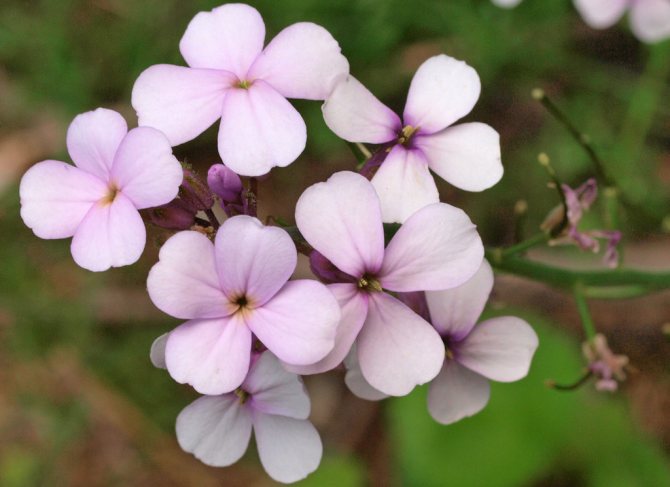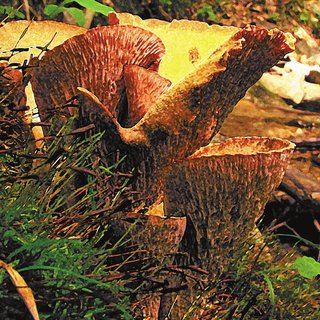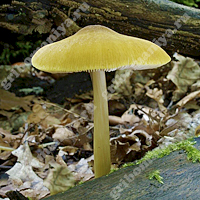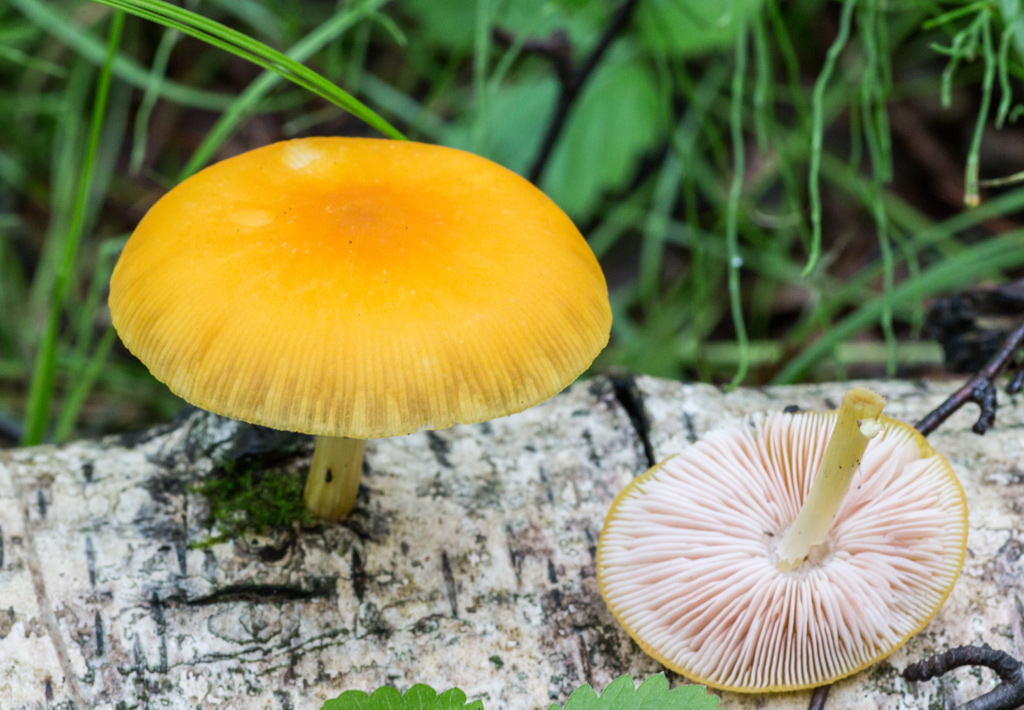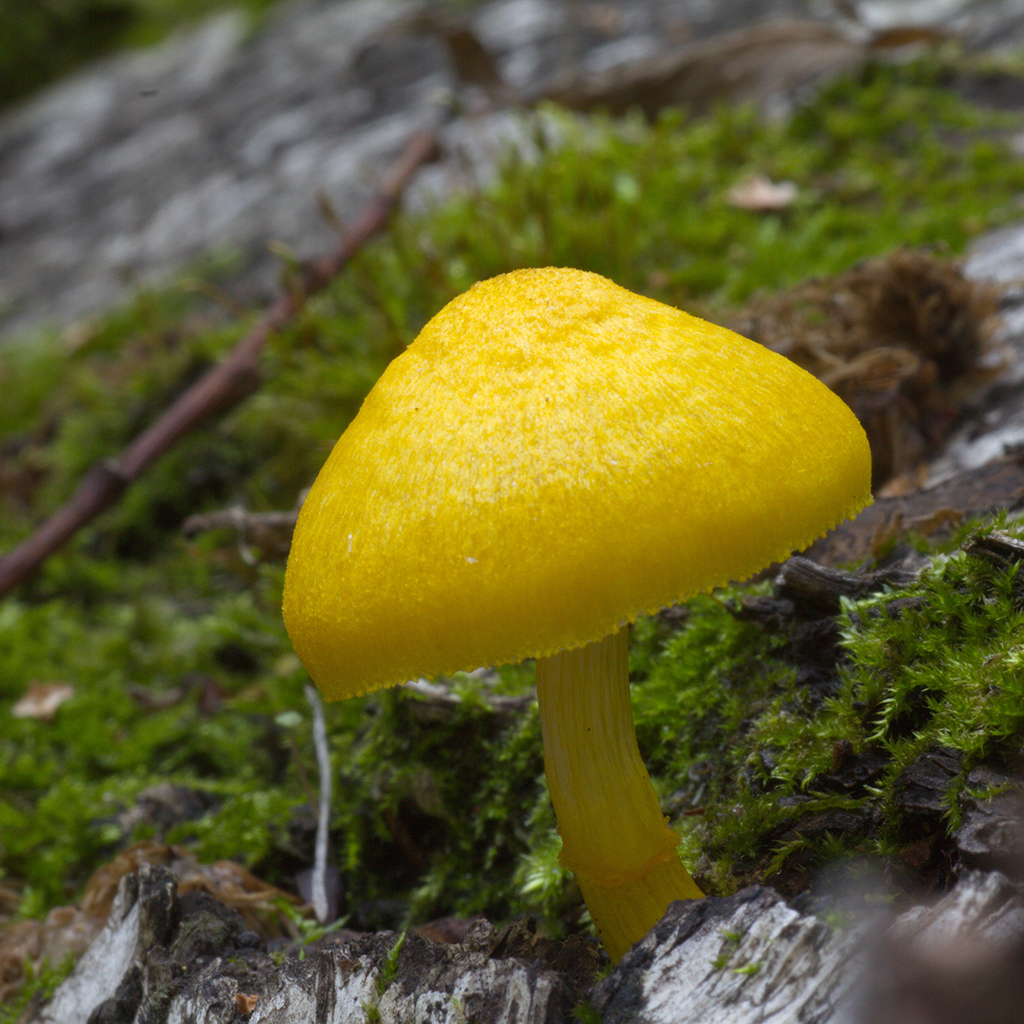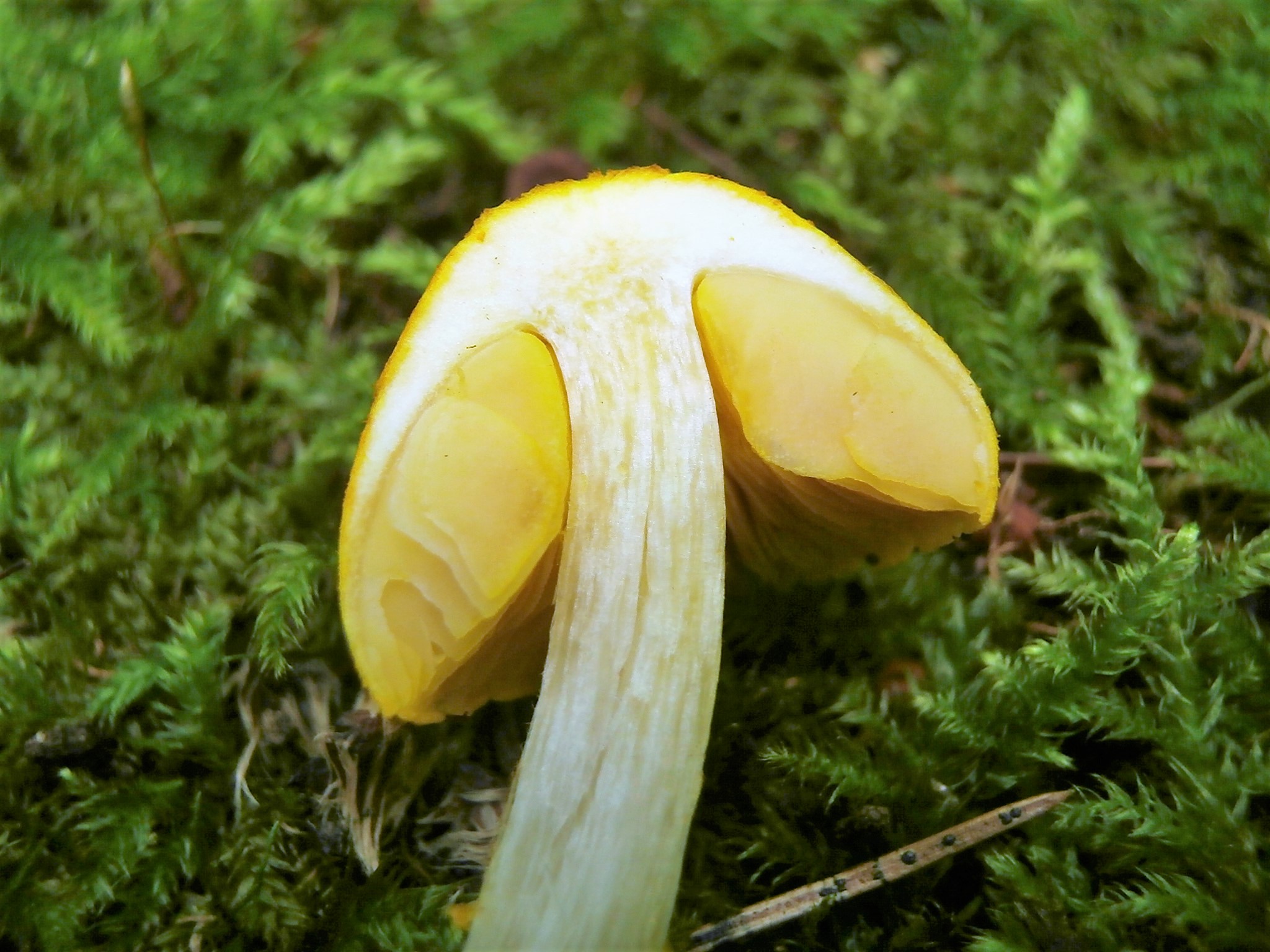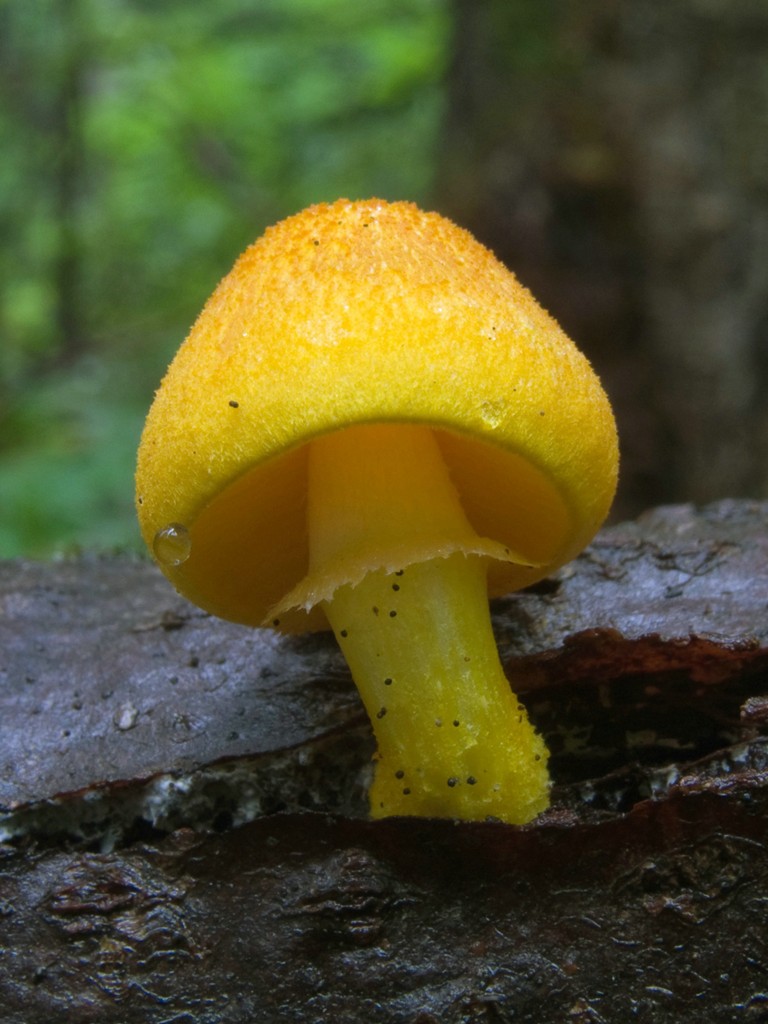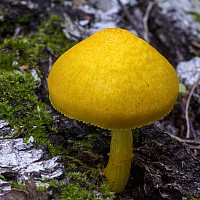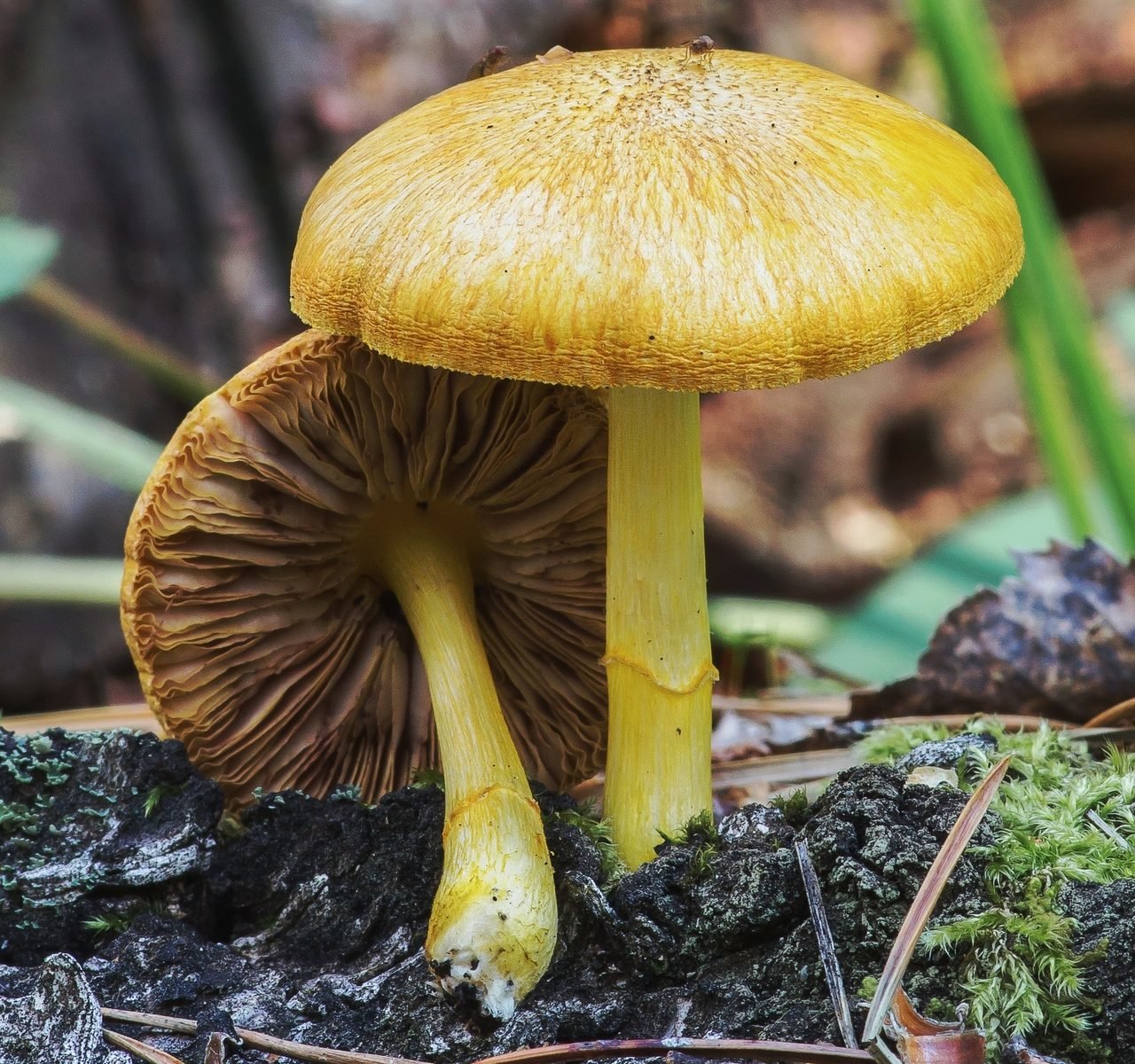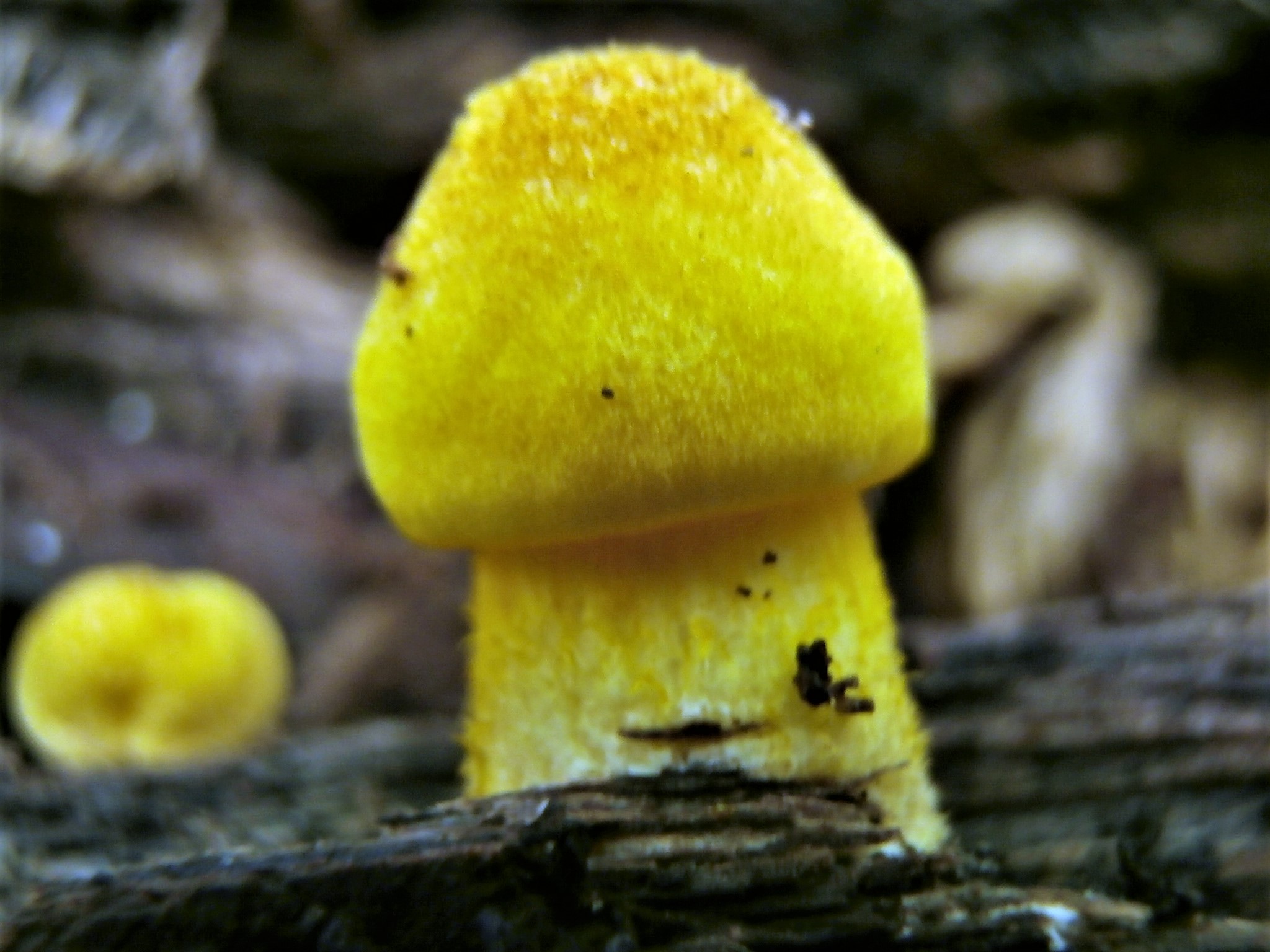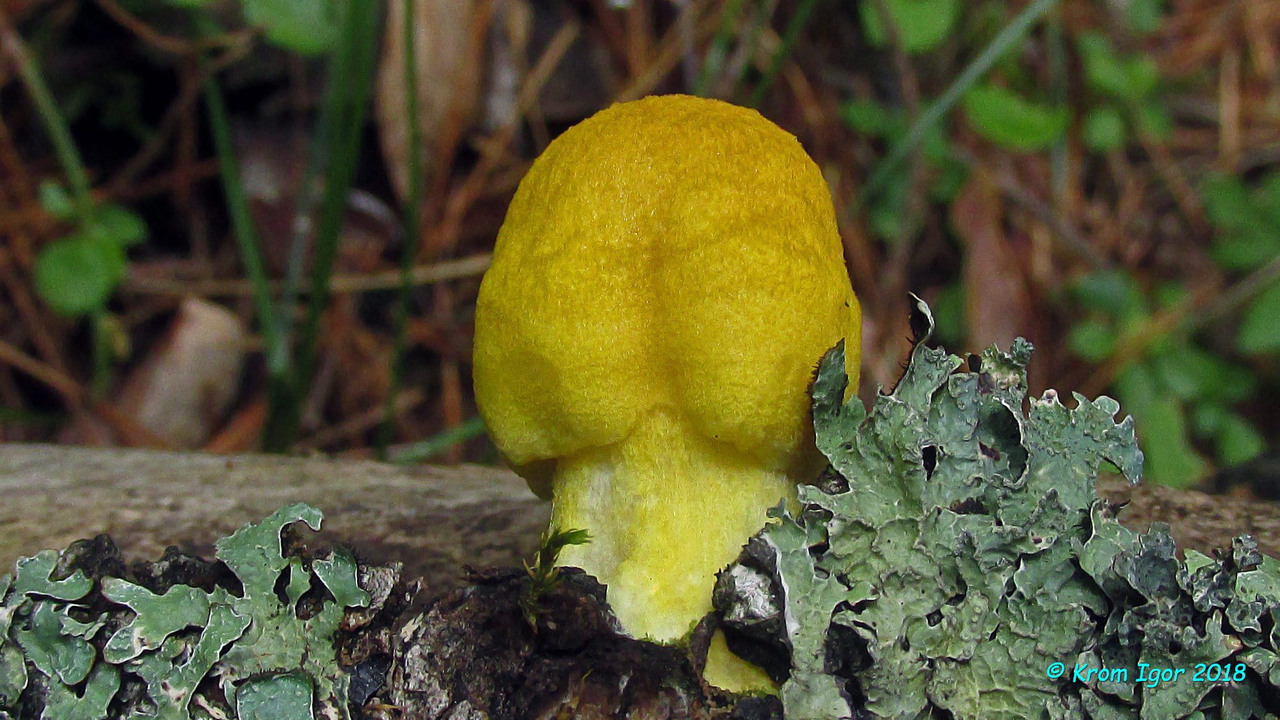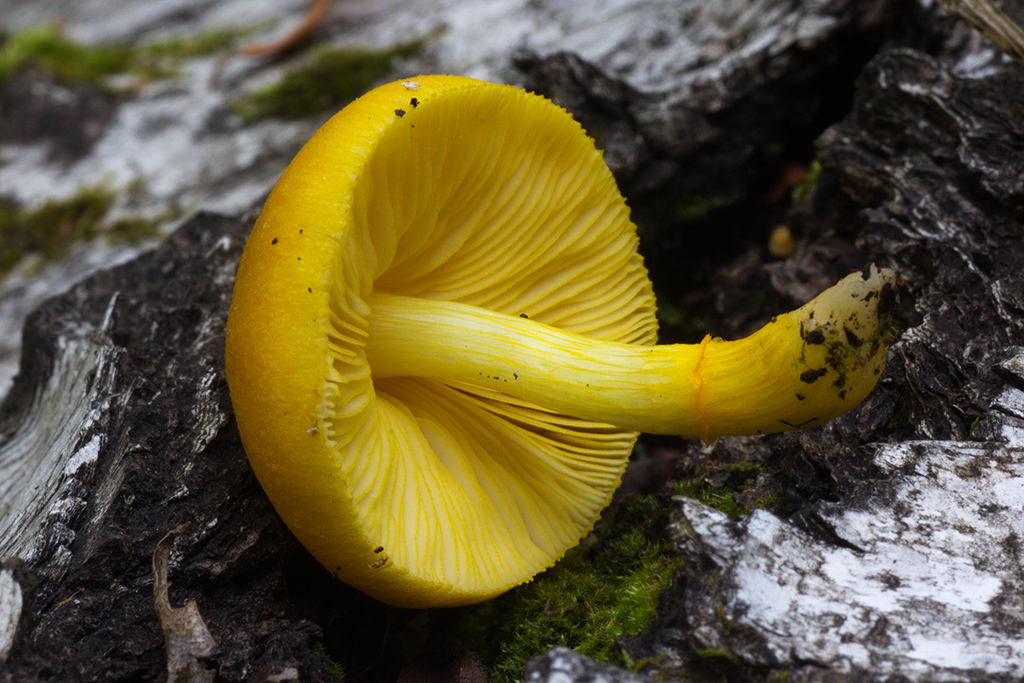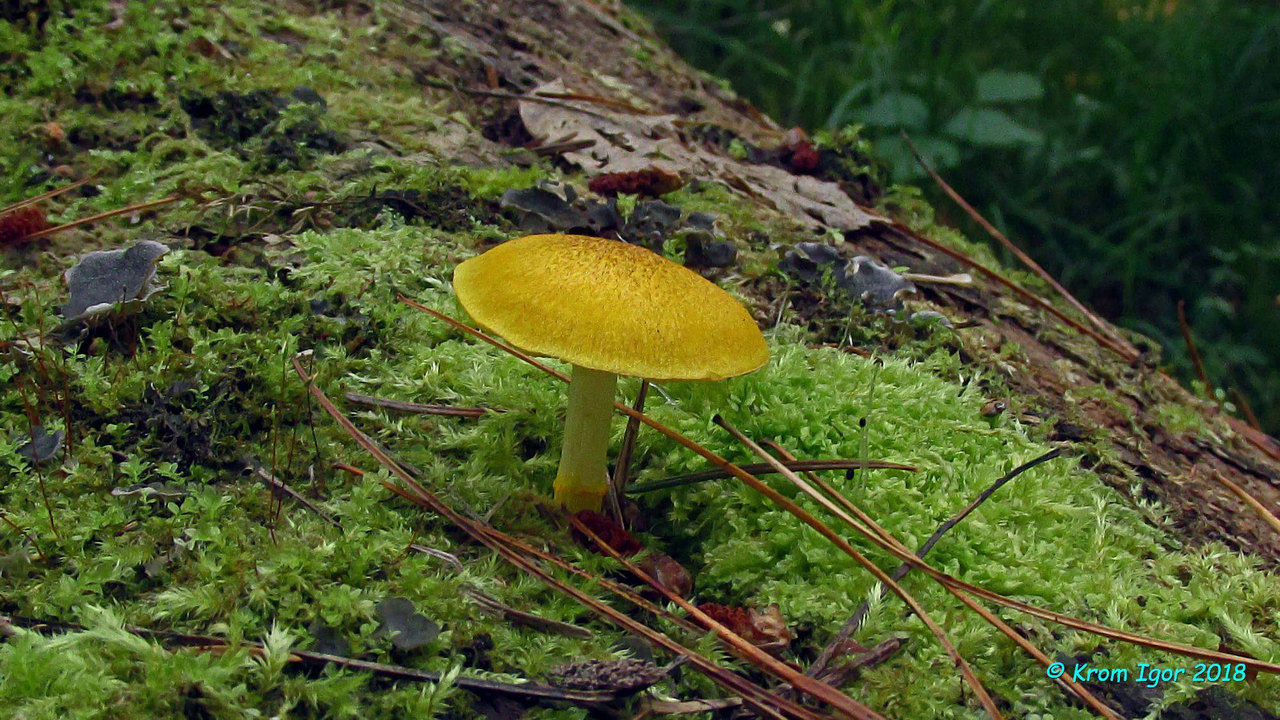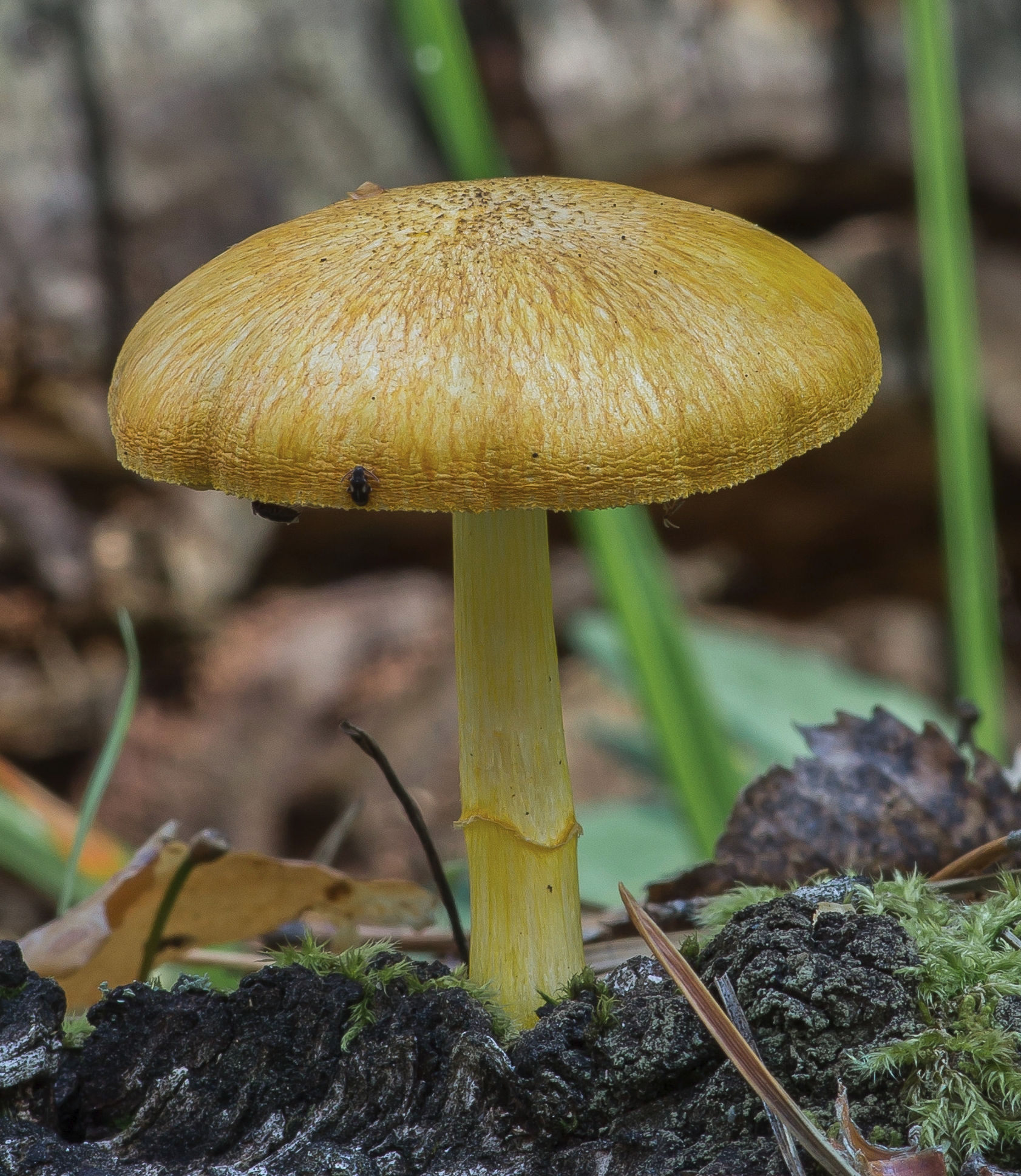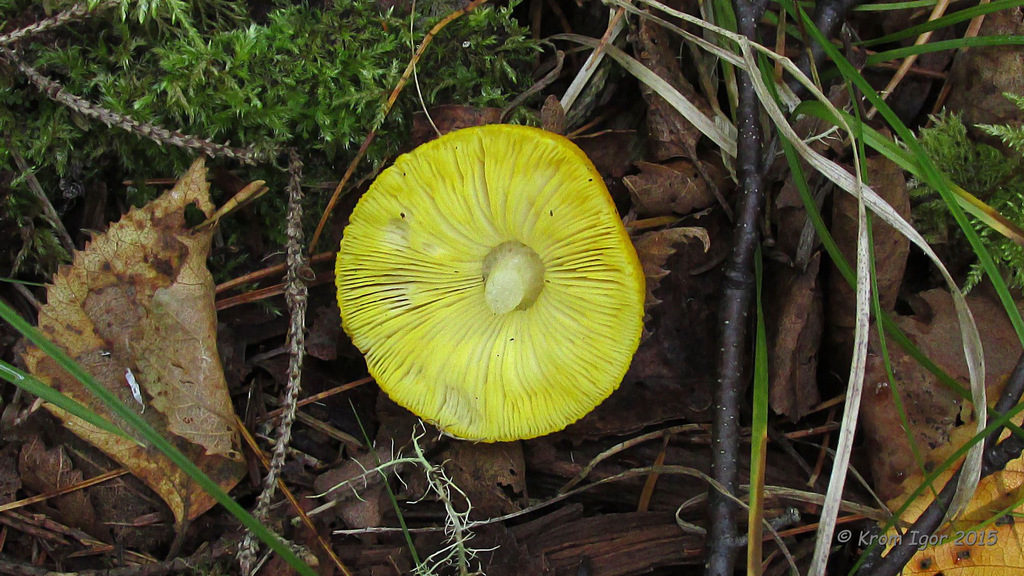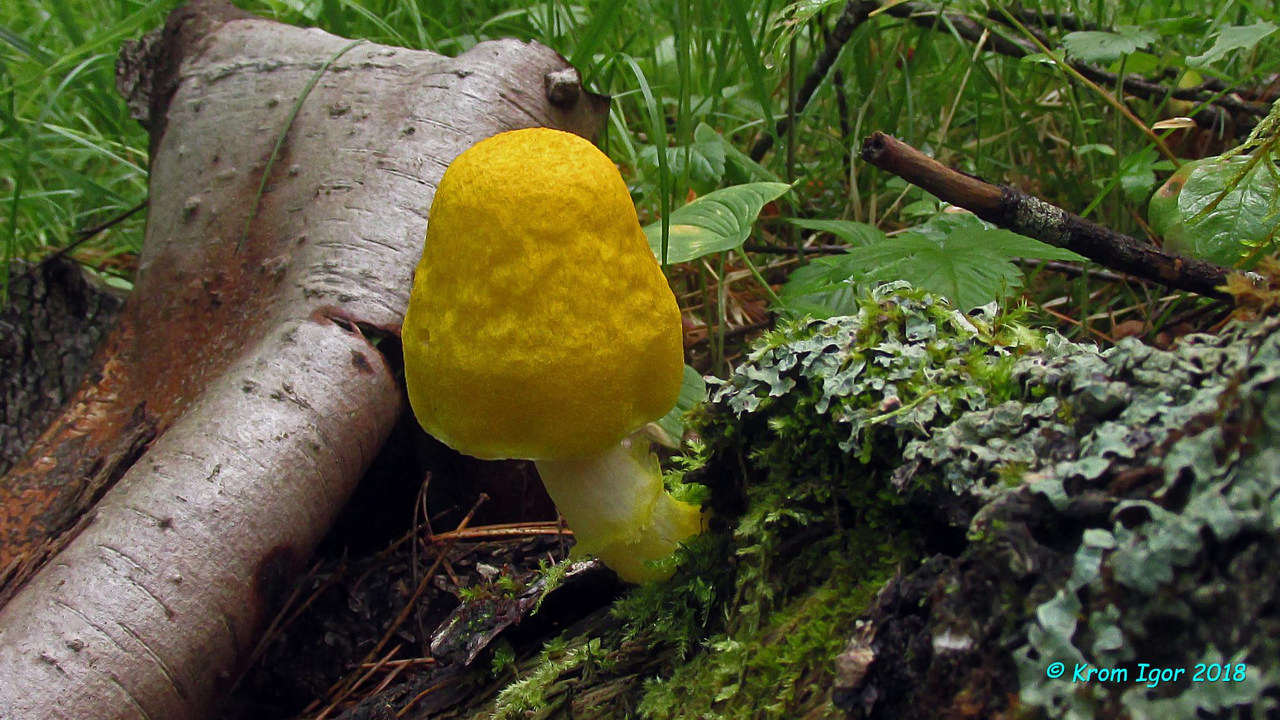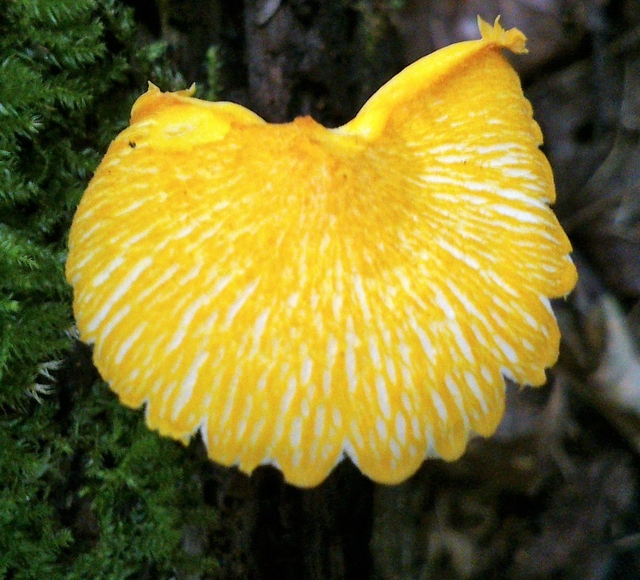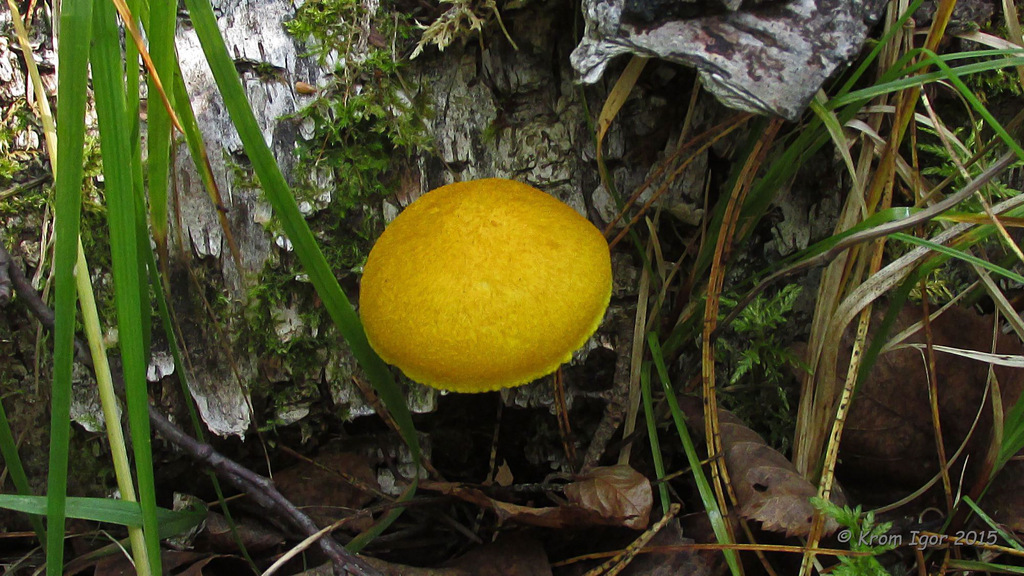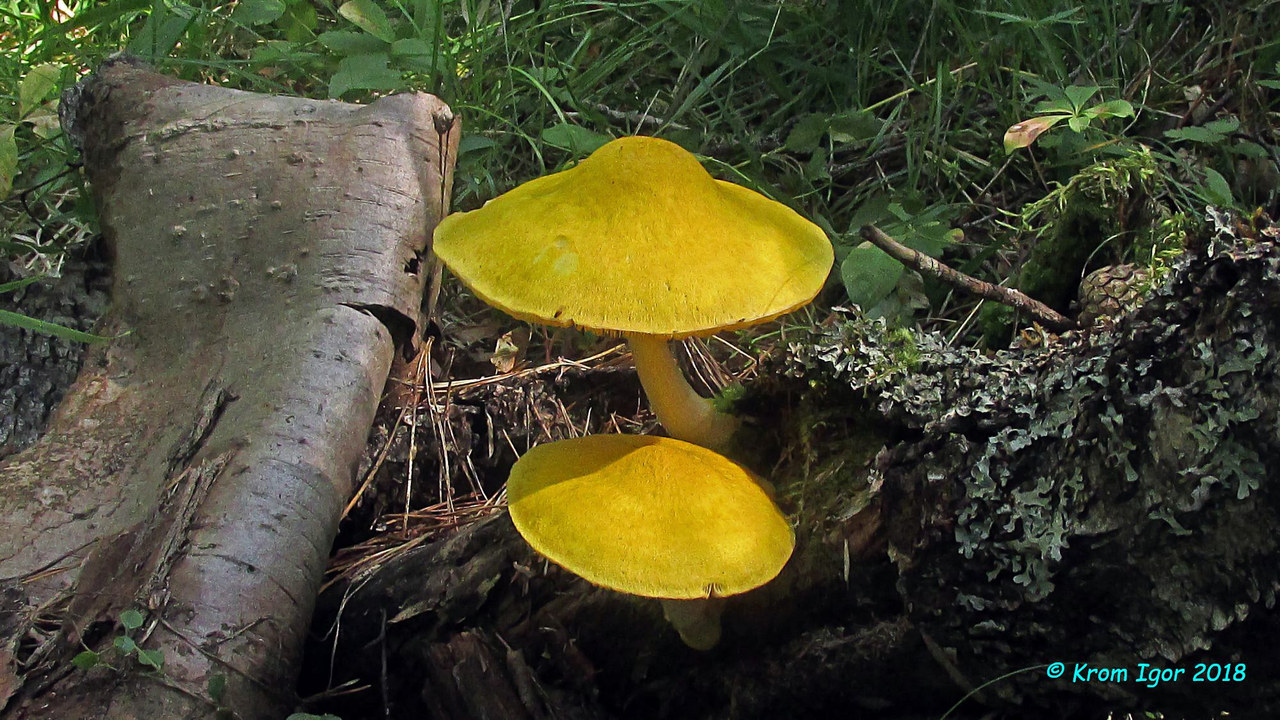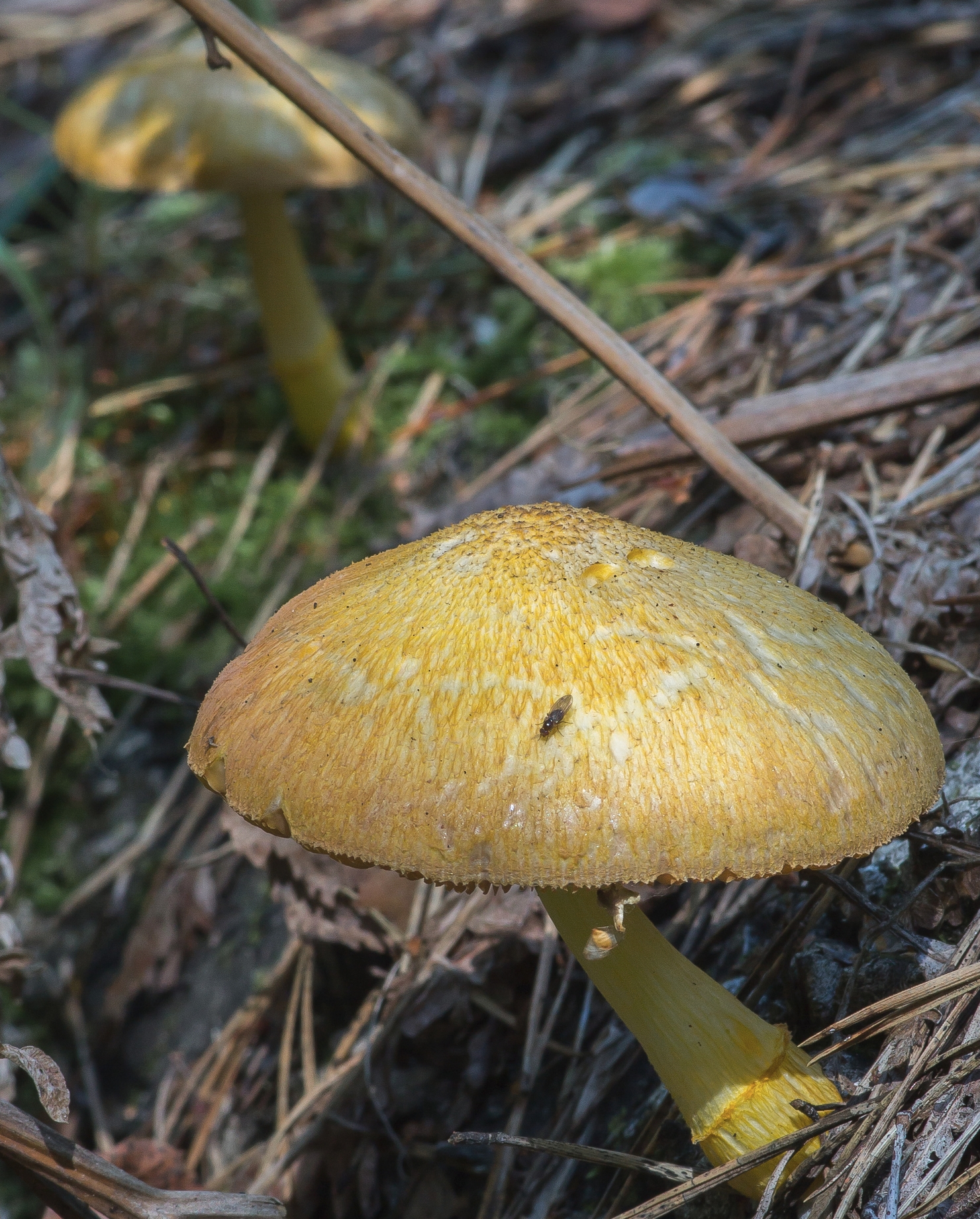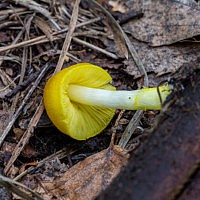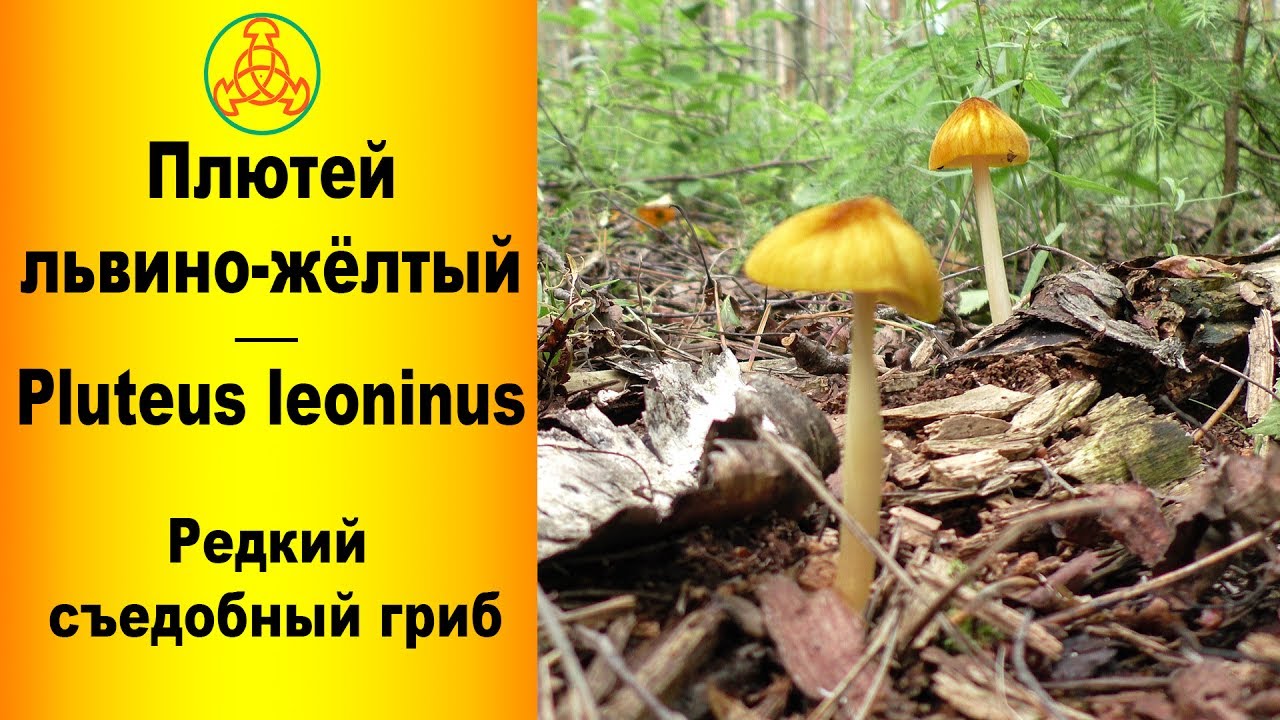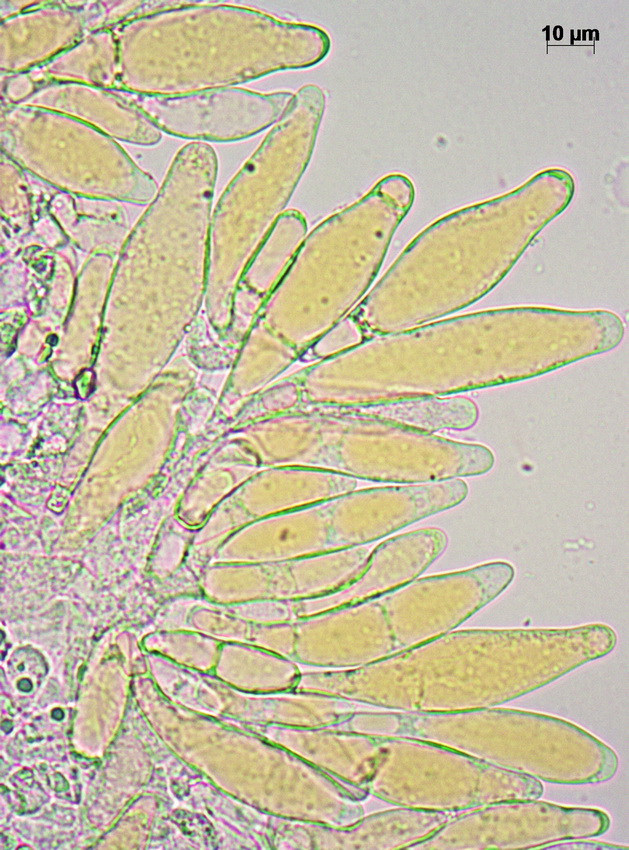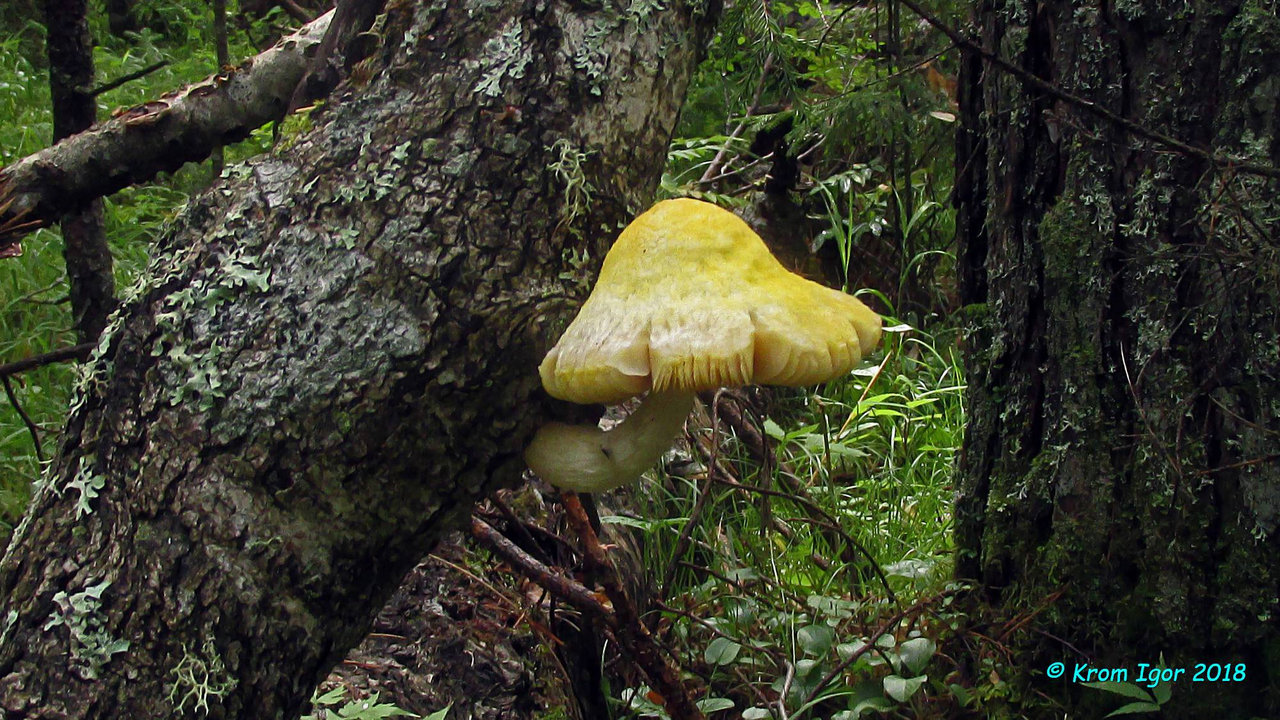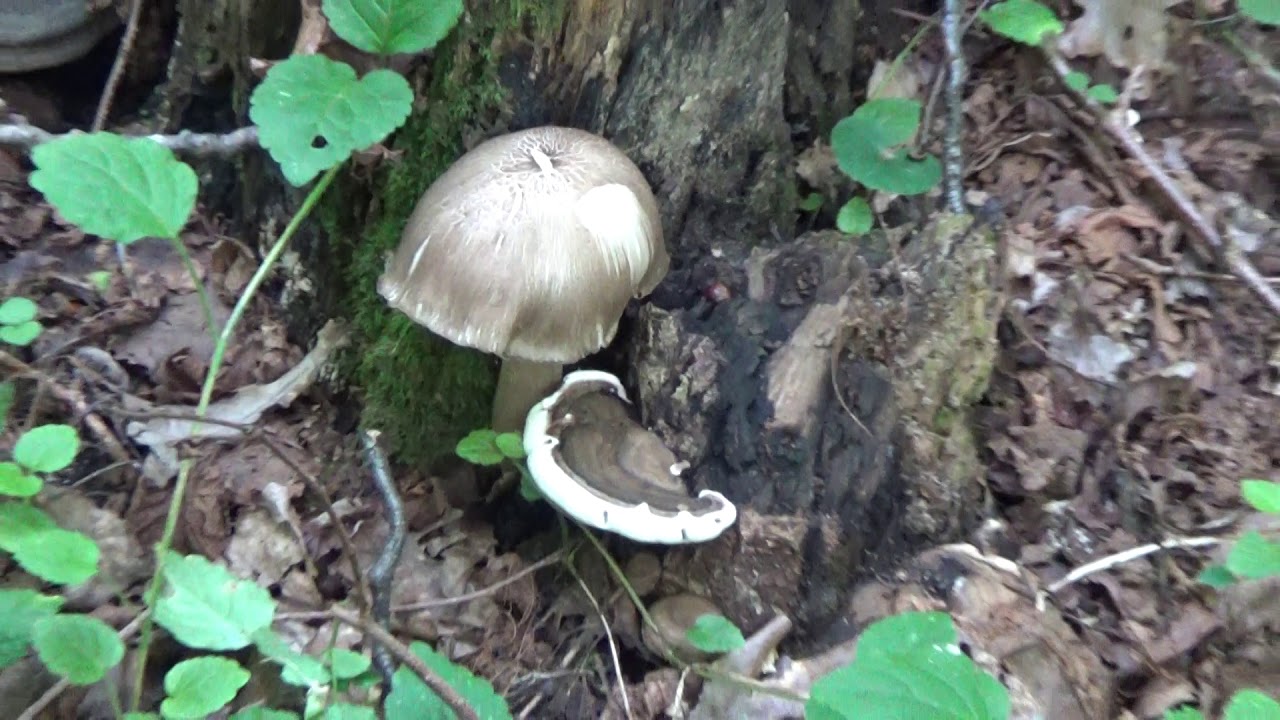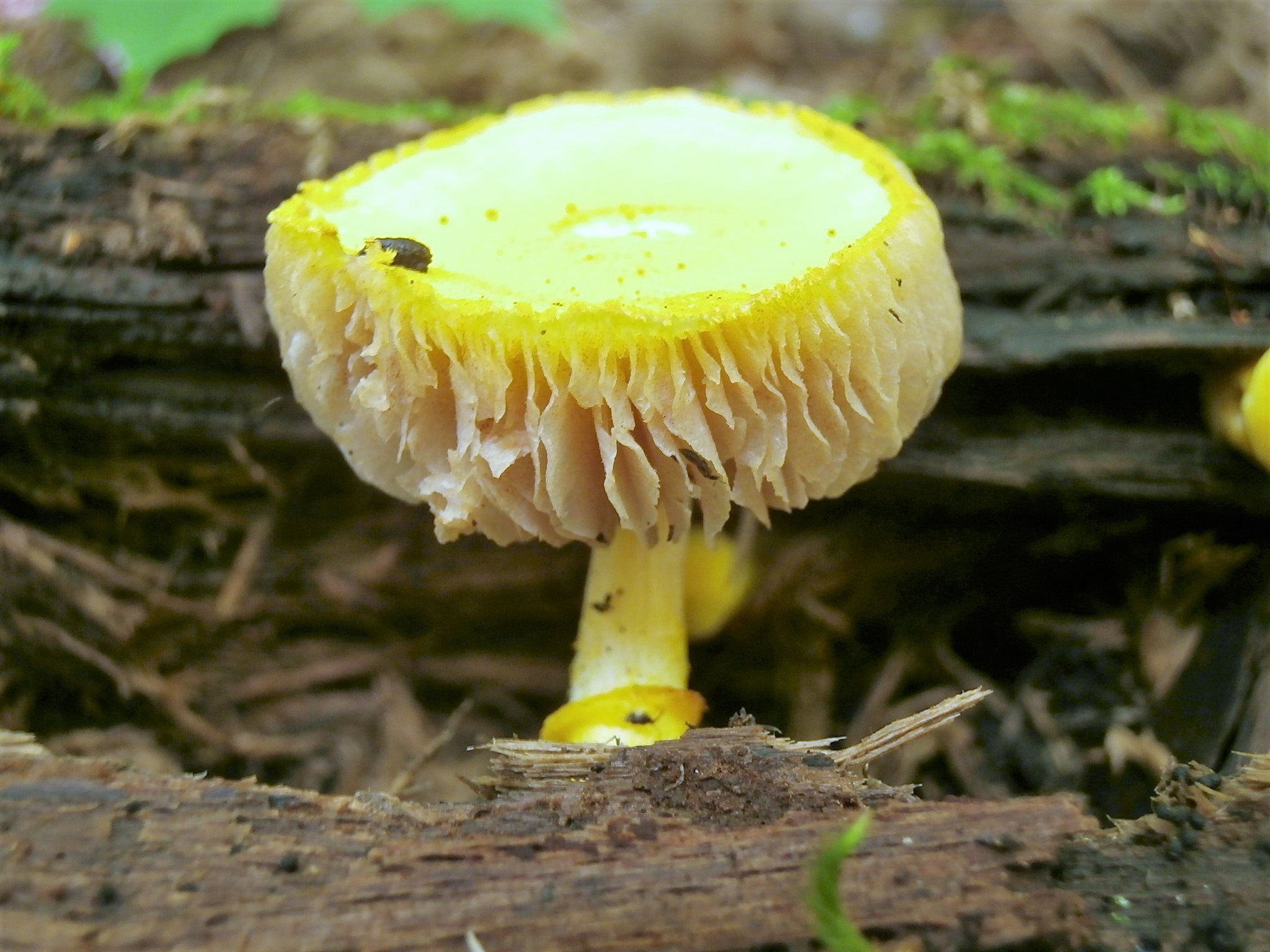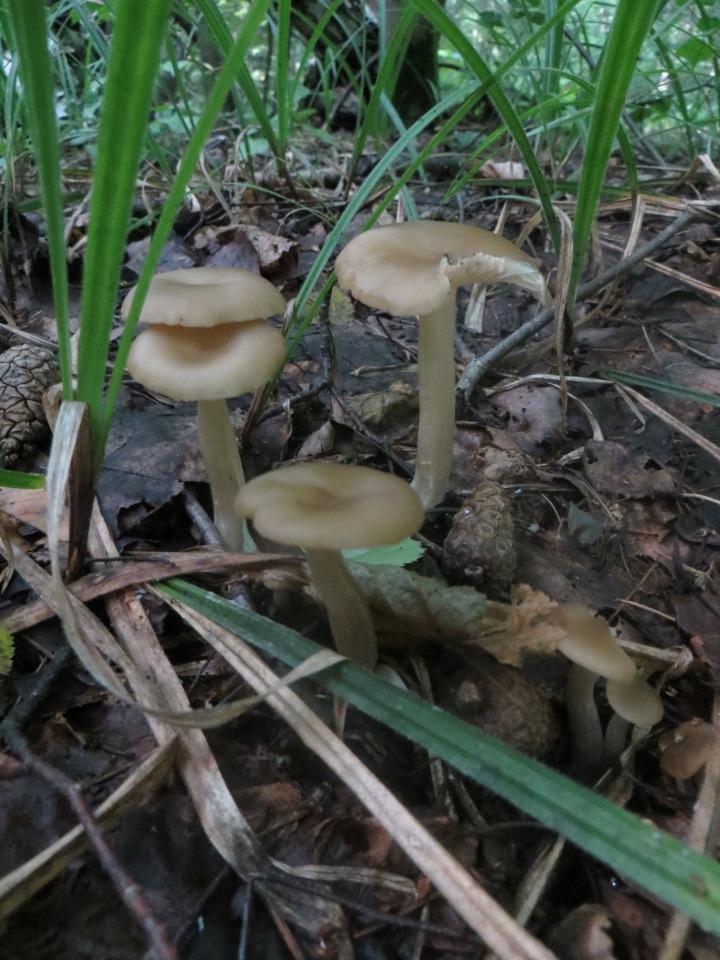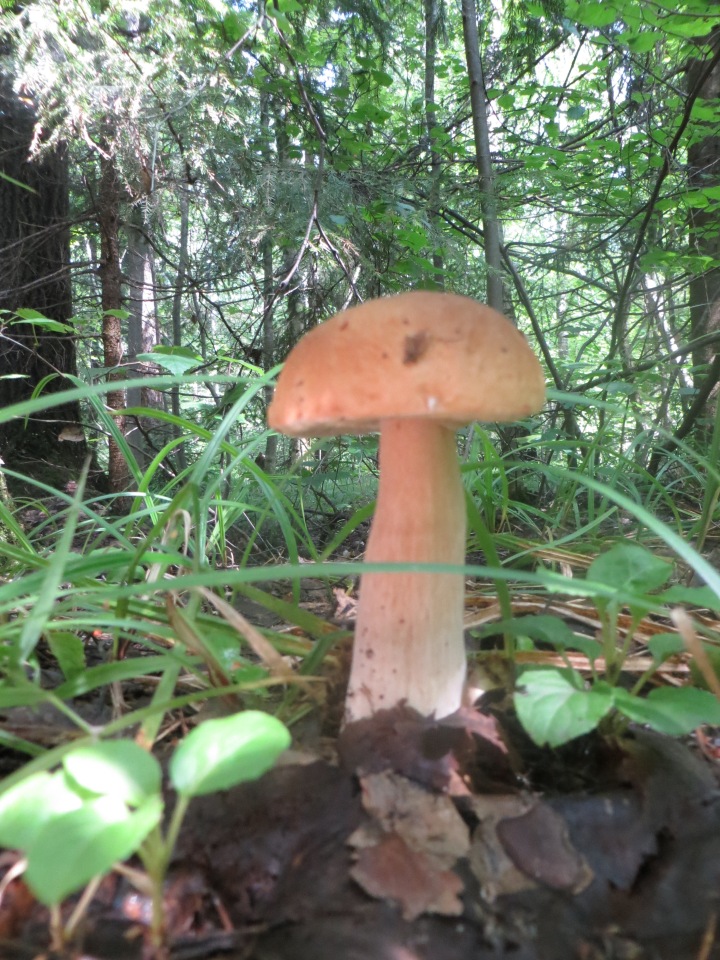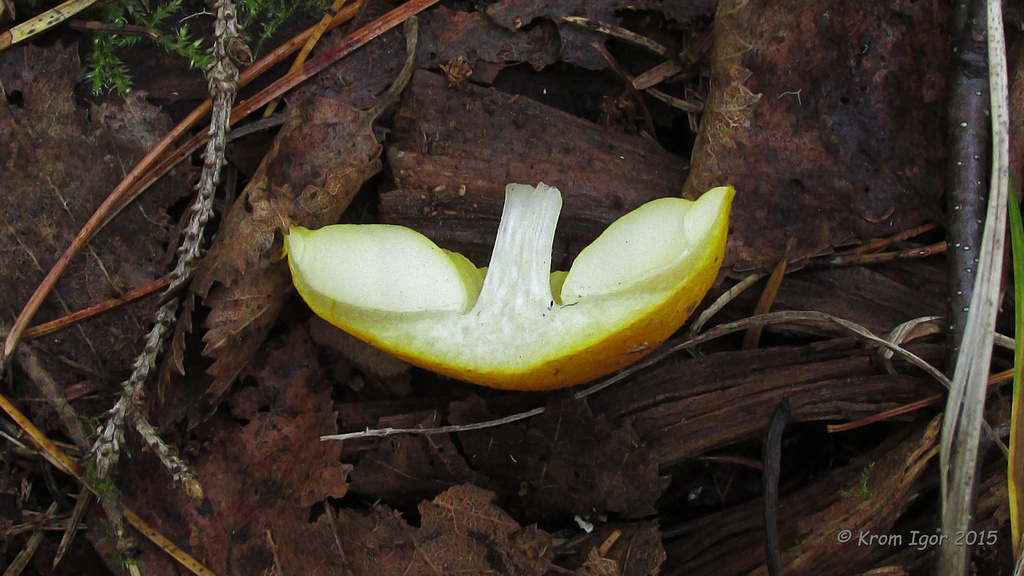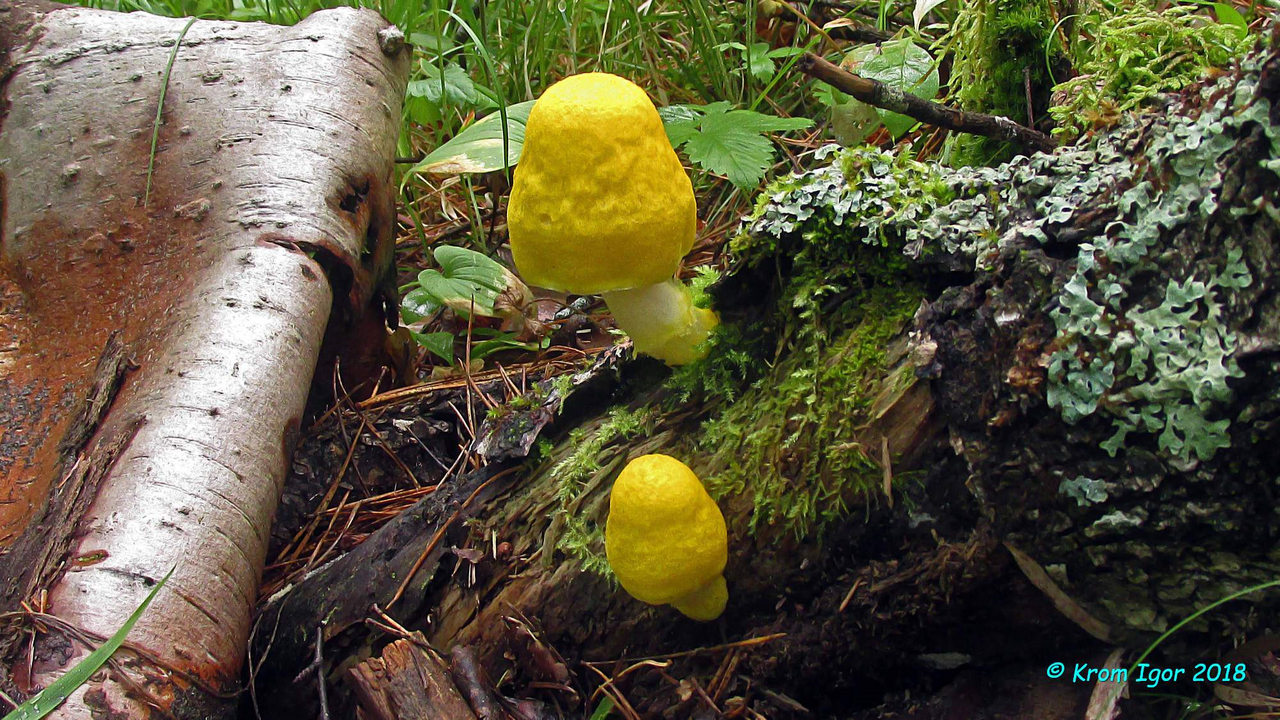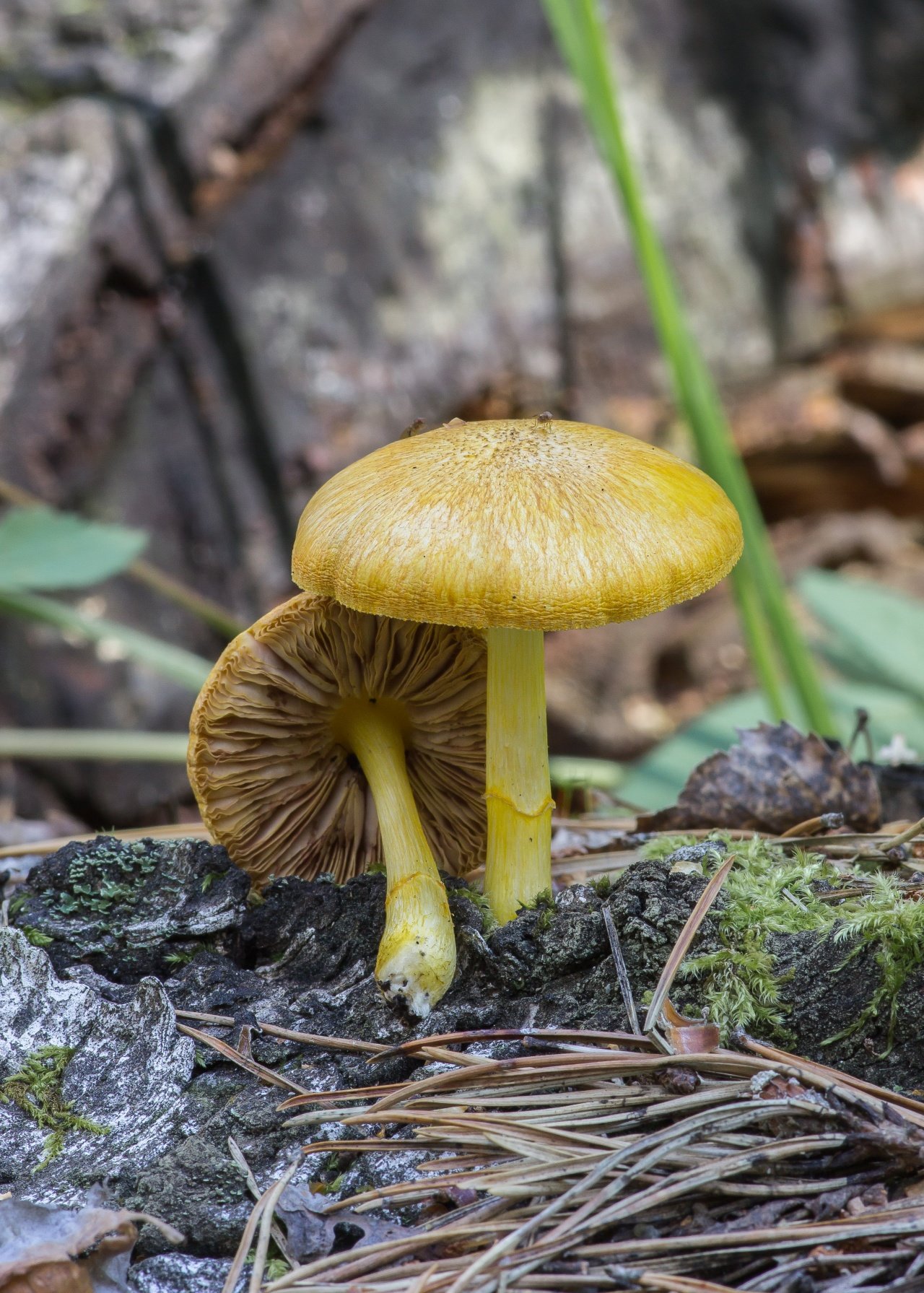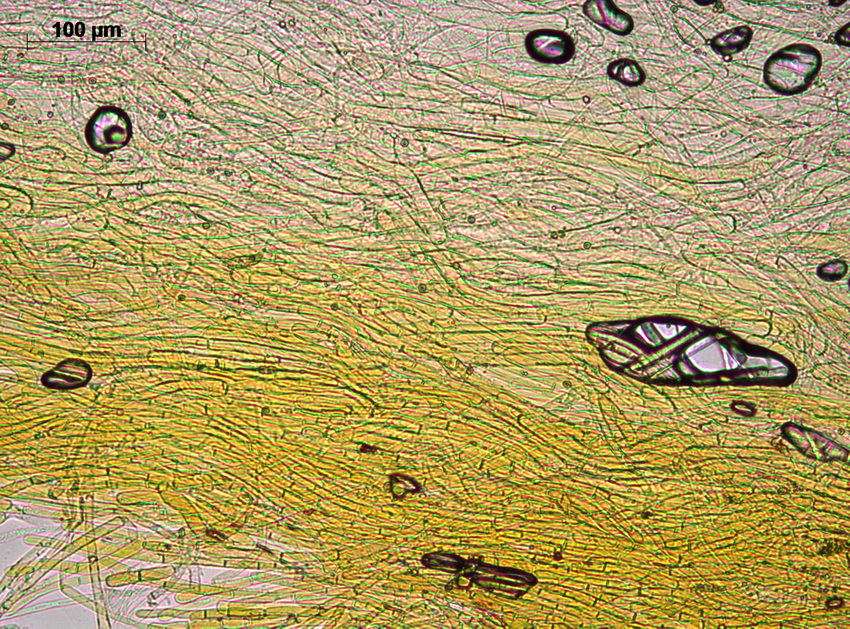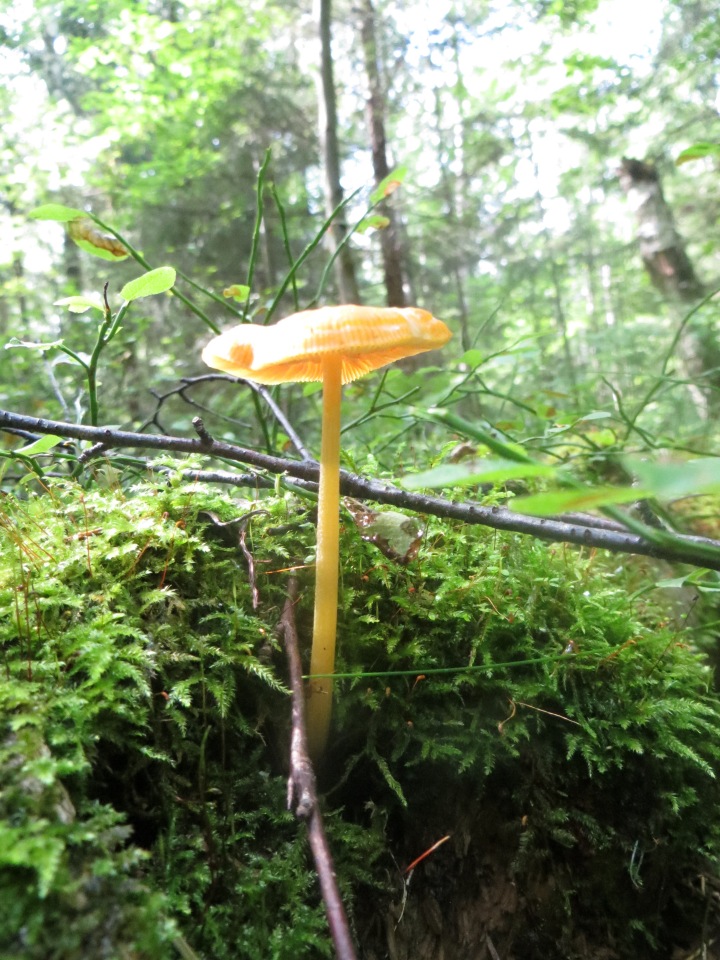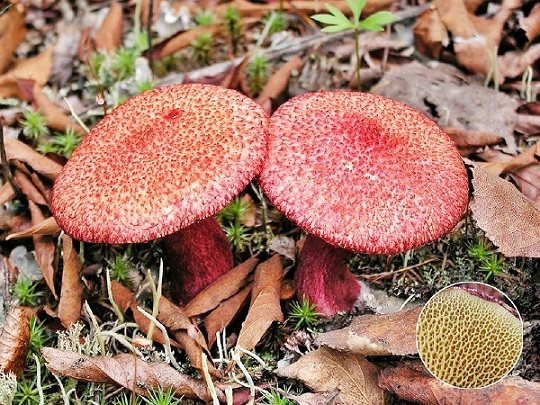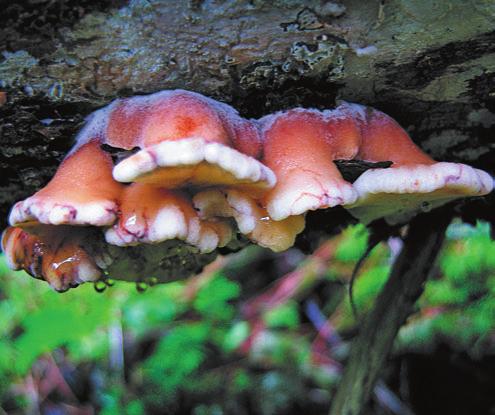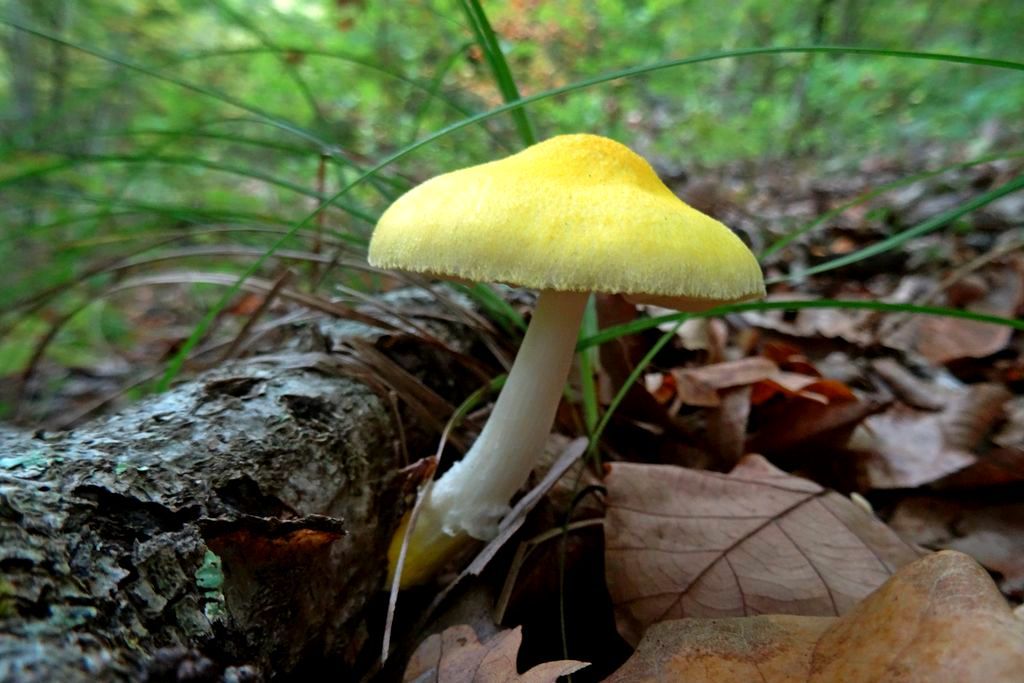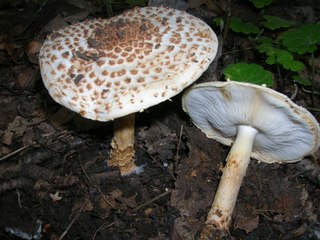Definitioner
- Basidia (Basidia)
-
Lat. Basidia. A specialized structure of sexual reproduction in fungi, inherent only in Basidiomycetes. Basidia are terminal (end) elements of hyphae of various shapes and sizes, on which spores develop exogenously (outside).
Basidia are diverse in structure and method of attachment to hyphae.
According to the position relative to the axis of the hypha, to which they are attached, three types of basidia are distinguished:
Apical basidia are formed from the terminal cell of the hypha and are located parallel to its axis.
Pleurobasidia are formed from lateral processes and are located perpendicular to the axis of the hypha, which continues to grow and can form new processes with basidia.
Subasidia are formed from a lateral process, turned perpendicular to the axis of the hypha, which, after the formation of one basidium, stops its growth.
Based on morphology:
Holobasidia - unicellular basidia, not divided by septa (see Fig. A, D.).
Phragmobasidia are divided by transverse or vertical septa, usually into four cells (see Fig. B, C).
By type of development:
Heterobasidia consists of two parts - hypobasidia and epibasidia developing from it, with or without partitions (see Fig. C, B) (see Fig. D).
Homobasidia is not divided into hypo- and epibasidia and in all cases is considered holobasidia (Fig. A).
Basidia is the place of karyogamy, meiosis and the formation of basidiospores. Homobasidia, as a rule, is not functionally divided, and meiosis follows karyogamy in it. However, basidia can be divided into probasidia - the site of karyogamy and metabasidia - the site of meiosis. Probasidium is often a dormant spore, for example in rust fungi. In such cases, probazidia grows with metabasidia, in which meiosis occurs and on which basidiospores are formed (see Fig. E).

See Karyogamy, Meiosis, Gifa.
- Pileipellis
-
Lat. Pileipellis, skin - differentiated surface layer of the cap of agaricoid basidiomycetes. The structure of the skin in most cases differs from the inner flesh of the cap and may have a different structure. The structural features of pileipellis are often used as diagnostic features in descriptions of fungi species.
According to their structure, they are divided into four main types: cutis, trichoderma, hymeniderma and epithelium.
See Agaricoid fungi, Basidiomycete, Cutis, Trichoderma, Gimeniderm, Epithelium.
- Hymeniderm
-
The type of cap skin, consists of non-septic elements located more or less perpendicular to the surface and laid on the same level, resembling the hymenial layer.
Lat. Hymeniderm.
It is subdivided into trichogymenidermis, eugymenidermis, epithelioid hymenidermis.
There is also a transitional structure of the skin from the hymenidermis to the epithelium. (A mixture of rounded cells, characteristic of the epithelium, but located in one layer, and pear-shaped cells, characteristic of hymenidermis, lying at the same level.)
See Gymnial layer, Trichogymenidermis, Eugymenidermis, Epithelioid hymenidermis, Epithelium, Septa.
Interesting facts about the mushroom
According to some sources, the name of the reindeer plyuti is an interpretation of its Latin name Pluteus cervinus. However, this is not quite true. The fact is that "cervinus" can be interpreted not only as "deer", but also as "toothed". This name comes from the characteristic jagged edges of the mushroom. The word "pluteus" can be translated as "canopy".
The extract of organic matter from plute can slow down the development of malignant tumors, and also enhances the general immunity of the body.
In reference books, you can find various characteristics of the edibility of the mushroom. For example, in Italian sources it is listed as inedible.
Several species of the family contain psilocybin, a powerful hallucinogenic substance.
External description
The fruiting body of the willow spit is capillary.His pulp is fragile, thin, watery, characterized by a whitish-gray or white color, in the area of the leg from the inside - loose, when broken it becomes slightly greenish. The aroma and taste can be inexpressive or rather weak and rare.
The hat is 2 to 5 cm in diameter (sometimes 8 cm), initially it has a conical or convex shape. In mature fruiting bodies, it becomes flat-spread or flat-convex. In the central part of the cap, a thin-scaly, wide and low tubercle is often noticeable. The surface of the mushroom cap of the willow spit is shiny, radially fibrous, and the fibers are somewhat darker in color than the main shade. The color of the cap of the described mushroom can be grayish-green, brownish-gray, gray-bluish, brown or ash gray. The edges of the cap are often sharp and striped at high humidity levels.
The length of the stem of the fungus ranges from 3 to 5 (sometimes 10) cm, and the diameter is usually from 0.3 to 1 cm. In shape, it is often cylindrical, longitudinally fibrous, and may be slightly thickened near the base. In structure, the leg is even, only occasionally it is curved, with fragile pulp. It is white in color, with a shiny surface, in some fruit bodies it can have a grayish, olive, bluish or greenish tint. On old fruiting bodies, bluish or gray-green spots are often noticeable. The same marks appear with strong pressure on the mushroom pulp.
Fungal hymenophore - lamellar, consists of small, often spaced plates, which are initially cream or white in color. Ripe spores turn pinkish or pinkish brown. They are broadly ellipsoidal in shape, smooth in texture.
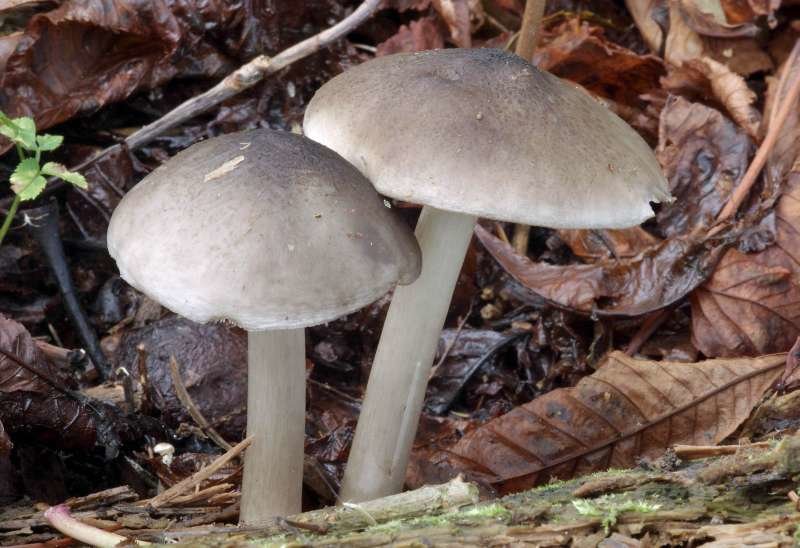
The edibility of the spit
Among the edible species, the most famous is the reindeer roach, although it is rarely harvested, the umber roach, the dark-edged roach. The inedible ones include velvety-legged roaches, noble rooks. Some of the species are described as little-known edible mushrooms, for example, dwarf roach, vein roach. Species for which nutritional properties have not been studied are traditionally referred to as inedible.
Despite its fame, the edible plute is characterized by a pleasant, sweetish taste and smell, reminiscent of potatoes. The delicate and fleshy pulp of these mushrooms perfectly retains its properties when drying, frying and boiling. In traditional dishes of northern peoples, plute is used even raw.
Young mushrooms are eaten. A ripe stick acquires a peculiar sour taste, which is not dangerous to health, but spoils the nutritional quality of food.
Composition, taste assessment and recipes
Reindeer roach mushroom is edible, but it is ranked only in the fourth nutritional value category.
In other words, it must be used with extreme caution and pretreated.
Taste and aroma qualities are rather modest. You can find both positive and negative reviews. The mushroom is disliked for the tastelessness and wateriness of the pulp. Also, many note the presence of a not very pleasant radish smell, which does not disappear even after prolonged processing.
Nevertheless, some substances beneficial to the body have been found in the spit, such as:
- Vitamins. Some researchers report the presence of B, C, and D groups in fruits, and in large quantities. Pluteus cervinus can compete with beef liver in terms of its vitamin content.
- Lecithin. Natural fighter against cholesterol and a remedy for the overall health of the body.
- Enzymes. Substances related to dietary supplements. Although their value has not yet been scientifically proven.
It works well for the following dishes:
- Beef stroganoff. Dried mushrooms crushed into crumbs are used. Meat breaded in flour is fried with sour cream and onions, adding mushroom powder to this mixture.
- Soup. Stewed vegetables and chopped spits are used as a base. The mixture is fried and then added to the broth.
- Marinated mushrooms.To prepare the dish, the fruits are peeled and the top layer of the cap is removed from them. Next, they must be boiled in salted water with spices. After that, the product is placed in a sterile container, tamped and poured with vinegar and broth remaining after cooking.
False doubles
Most of them belong to rather safe and low-toxic mushrooms. The most similar species and the level of their edibility are shown in the table.
| Mushroom name | Edibility | Features of the mushroom |
| Black-sided Plutey | Edible but little known | Unlike its counterpart, the edges of the plates under the cap have a dark, burgundy or brown edging. The fungus is less common, mainly in coniferous forests. It has a faint pleasant smell and a white or yellowish flesh that does not change color when cut. |
| Pouzar's clown | Edible unknown | Differs in the structure of the colored cap skin. It is more fibrous and begins to flake off over time. The plates also differ, but not in color, but in structure: between the long plates there are shorter ones, usually at the very edge of the cap. |
| Volvariella (a genus of mushrooms of the same family) | Mostly edible | A number of representatives of the genus Volvariella are extremely similar to the deer mushroom. Mushrooms are considered edible and are even cultivated in some countries. They are distinguished by the presence of a blanket, a small sac in which the fruiting body is in the early stages of growth. Over time, it breaks, leaving a semblance of a calyx at the base of the mushroom. |
| Entoloma (a genus of fungi of the Entolomaceae family) | Low edible, most species are toxic | Fungi of this genus are poorly studied and rare, but most of the samples found contain toxins that cause severe food poisoning. It is easy to distinguish them from spitters by the characteristic accretion of plates to the stem of the fungus (whereas in the spit of a deer plate, the plates are "free"). The place of growth is also different. Entholomaceae prefer to grow in soil rather than on dead wood. |
| Colibia wide-lamellar | Inedible | The plates of the fungus are located much less frequently, they are yellowish, not pink. As with entol, the plates grow a little to the stem. At the base of the mushroom there is a clearly visible constriction (like a step), sometimes framed by a short white skirt. The leg itself narrows towards the base, while in the spit it, on the contrary, expands. |
Season and habitat of the mushroom
The active fruiting of willow spitters occurs in the period from June to October (and when growing in warm climatic conditions, the mushroom bears fruit from early spring to late autumn). The described species of mushrooms grows mainly in mixed and deciduous forests, prefers wet areas and belongs to the saprotroph category. Often found alone. Rarely, willow plots can be seen in small groups (several fruiting bodies in a row). The fungus grows on fallen leaves of trees, near roots, willow, alder, birch, beech, linden and poplars. Sometimes the willow stick can also be seen on the wood of conifers (including pines or spruces). Willow plyutia is widespread in Europe, North America, Asia and North Africa. You can also see this type of mushroom in the Caucasus, Eastern Siberia, Kazakhstan, in Russia (European part), in the Far East.
Growing a mushroom mushroom at home
To grow the spit, a homogeneous or combined substrate of two or more constituents is prepared in any proportions (for example, just straw, or straw with sawdust and hay), it is placed in a container and poured with boiling water. The steamed substrate is allowed to cool down to 20-30 ° C. Then it is squeezed well and thoroughly mixed with mycelium (1 pack for 15 kg of moistened substrate). The resulting mixture is placed in a transparent plastic bag, lightly crushed and tied. To ensure air exchange, incisions are made about the entire area of the package (3-5 cm).
The mushroom block obtained in this way is left indoors or in a shady place in the garden. During the first month of germination, he does not need lighting.First, fluff appears, then the substrate becomes white or yellowish and turns into a dense block. After 1.5-2 weeks, the rudiments of fruiting bodies appear and the block is placed in the light, and film cuts are made in the places of the rudiments. Fruiting occurs in waves, every 2-3 weeks. The largest harvest comes from the first 2 waves.
Also, cakes are grown on deciduous non-rotten wood.
To do this, pick up bars and logs 30-40 cm long and 25 cm in diameter. They are soaked in water for a week. Next, holes are drilled or sawed into them, into which the mycelium is placed (1 package per 15 kg), and from above they are sealed with a watering can with tape or laid with straw. The mycelium grows from 3 to 6 months at a temperature of 7-27 ° C. At this time, the bars are placed in shady places in the garden or in ventilated areas. The crop is harvested 1-2 times in the spring and 1-2 times in the fall.
Types of mushroom plyutei
Deer roach (Pluteus cervinus)
Also known as deer mushroom. Medium to large size, with a cap diameter of 4-10 cm, sometimes up to 20 cm.The surface is smooth, silky, fibrous, cracks in mature mushrooms, becomes dry or slightly mucous, gray or grayish brown, sometimes the color changes from fawn to dark brown and black. The length of the leg reaches 15 cm, the shape is cylindrical, curved, swollen at the base, the structure is dense, solid, the color is white or whitish-gray.
Deer roach is a cosmopolitan mushroom that is found all over the world, growing on the wood of deciduous and coniferous trees.
Edible mushroom.
White corkscrew (Pluteus pellitus)
The cap is 3-5 cm in diameter, finely fleshy, with a tubercle in the center, the edge is torn, lobed. The surface is smooth, whitish in color, gradually acquires a grayish, grayish-brown or bluish color in the center, covered with pink or brown fibers. The length of the leg is up to 6 cm, its surface is shiny, fibrous.
Distributed in Eurasia from Western Europe to Western Siberia, and in northern Africa, a rare species. Grows on beech wood.
Little known edible mushroom.
Pluteus lion-yellow (Pluteus leoninus)
The cap is up to 8 cm in diameter, the shape is bell-shaped or flat-convex, there is a tubercle in the center, the edge is serrated. The surface is bare along the edge, velvety in the center, finely scaly, bright yellow, dark in the center. The leg is up to 7 cm long, about 1 cm in diameter, smooth, white with a yellow base.
The species is widespread in Eurasia, in northern Africa, where it grows in oak and beech forests, and is rare.
Edible mushroom.
Umber roast (Pluteus umbrosus)
The mushroom is medium in size, with a cap diameter of up to 10 cm. The cap is tomentose, wrinkled, whitish or dark brown, the edge is serrated, fibrous. Leg up to 10 cm in length, whitish or brownish, longitudinally fibrous, scaly.
The species grows in Eurasia and North America, on the wood of deciduous trees, a rare species.
Conditionally edible mushroom, as its pulp is bitter, but during boiling the bitterness disappears.
Poisonous and inedible species of mushroom plyuch
Plutey noble (Pluteus petasatus)
The cap reaches 15 cm in diameter. Its color is light, from whitish to ocher, the surface is silky, shiny, dry, rarely slimy, in the center it is covered with small brownish scales.
The species is found in Eurasia from Western Europe to the Far East, as well as in North America, but it is a rare species and is included in the Red Data Books of the Yaroslavl and Arkhangelsk regions of Russia. Grows in deciduous and mixed forests on beech, oak, poplar wood.
Inedible mushroom.
Scaly corkscrew (Pluteus ephebeus)
The mushroom is medium in size, the diameter of the cap is about 9 cm, the leg is 10 cm long. The surface of the cap is fibrous, grayish-brown, covered with scales in the center, cracking. The stem is whitish, shiny, smooth, with grooves.
Rare view. Grows on the wood of deciduous trees, distributed in Eurasia and North Africa.
Inedible mushroom.
Dwarf clown (Pluteus nanus)
The hat does not exceed 5 cm in diameter, the surface is velvety, wrinkled, brownish or chestnut-brown in color with a green tint, covered with a coating. Leg up to 5 cm long, light, with a yellowish or brown tint, smooth, shiny, fibrous.
The species is common in deciduous forests of Eurasia and North America.
Inedible mushroom.
Willow roach (Pluteus salicinus)
The diameter of the cap is up to 7 cm, the structure is thick-fleshed, the shape is from bell-shaped to flat-spread, with a tubercle. The edge is finely fleshy. The surface is shiny, wrinkled, covered with scales in the center, grayish or ash-gray with a bluish or pinkish-brown tint, darker in the center. Leg up to 12 cm long, shiny, bluish or grayish-olive.
Grows on wood of willow, alder, poplar, oak, beech. Found in Eurasia, North Africa and North America, a rare species.
Hallucinogenic mushroom.
In addition, there are genera of mushrooms with fruiting bodies similar to spits. One of them is entoloma, for which poisonous species are known. These mushrooms are distinguished by the fact that their plates are either narrowly adherent or creeping down, but they are never free, like that of a spit.
In the Rhodocybe fungi of the entolomaceae family, the plates are adherent and descending, the cap is with a depression in the center, and their spores are ornamented.
The clitopils have a depression on the cap, the plates are descending, the spores are striped.
Types of mushroom plyutei
Deer roach (Pluteus cervinus)
Also known as deer mushroom. Medium to large size, with a cap diameter of 4-10 cm, sometimes up to 20 cm.The surface is smooth, silky, fibrous, cracks in mature mushrooms, becomes dry or slightly mucous, gray or grayish brown, sometimes the color changes from fawn to dark brown and black. The length of the leg reaches 15 cm, the shape is cylindrical, curved, swollen at the base, the structure is dense, solid, the color is white or whitish-gray.
Deer roach is a cosmopolitan mushroom that is found all over the world, growing on the wood of deciduous and coniferous trees.
White corkscrew (Pluteus pellitus)
The cap is 3-5 cm in diameter, finely fleshy, with a tubercle in the center, the edge is torn, lobed. The surface is smooth, whitish in color, gradually acquires a grayish, grayish-brown or bluish color in the center, covered with pink or brown fibers. The length of the leg is up to 6 cm, its surface is shiny, fibrous.
Distributed in Eurasia from Western Europe to Western Siberia, and in northern Africa, a rare species. Grows on beech wood.
Little known edible mushroom.
Pluteus lion-yellow (Pluteus leoninus)
The cap is up to 8 cm in diameter, the shape is bell-shaped or flat-convex, there is a tubercle in the center, the edge is serrated. The surface is bare along the edge, velvety in the center, finely scaly, bright yellow, dark in the center. The leg is up to 7 cm long, about 1 cm in diameter, smooth, white with a yellow base.
The species is widespread in Eurasia, in northern Africa, where it grows in oak and beech forests, and is rare.
Umber roast (Pluteus umbrosus)
The mushroom is medium in size, with a cap diameter of up to 10 cm. The cap is tomentose, wrinkled, whitish or dark brown, the edge is serrated, fibrous. Leg up to 10 cm in length, whitish or brownish, longitudinally fibrous, scaly.
The species grows in Eurasia and North America, on the wood of deciduous trees, a rare species.
Conditionally edible mushroom, as its pulp is bitter, but during boiling the bitterness disappears.
Poisonous and inedible species of mushroom plyuch
Plutey noble (Pluteus petasatus)
The cap reaches 15 cm in diameter. Its color is light, from whitish to ocher, the surface is silky, shiny, dry, rarely slimy, in the center it is covered with small brownish scales.
The species is found in Eurasia from Western Europe to the Far East, as well as in North America, but it is a rare species and is included in the Red Data Books of the Yaroslavl and Arkhangelsk regions of Russia. Grows in deciduous and mixed forests on beech, oak, poplar wood.
Scaly corkscrew (Pluteus ephebeus)
The mushroom is medium in size, the diameter of the cap is about 9 cm, the leg is 10 cm long. The surface of the cap is fibrous, grayish-brown, covered with scales in the center, cracking. The stem is whitish, shiny, smooth, with grooves.
Rare view. Grows on the wood of deciduous trees, distributed in Eurasia and North Africa.
Dwarf clown (Pluteus nanus)
The hat does not exceed 5 cm in diameter, the surface is velvety, wrinkled, brownish or chestnut-brown in color with a green tint, covered with a coating. Leg up to 5 cm long, light, with a yellowish or brown tint, smooth, shiny, fibrous.
The species is common in deciduous forests of Eurasia and North America.
Willow roach (Pluteus salicinus)
The diameter of the cap is up to 7 cm, the structure is thick-fleshed, the shape is from bell-shaped to flat-spread, with a tubercle. The edge is finely fleshy. The surface is shiny, wrinkled, covered with scales in the center, grayish or ash-gray with a bluish or pinkish-brown tint, darker in the center. Leg up to 12 cm long, shiny, bluish or grayish-olive.
Grows on wood of willow, alder, poplar, oak, beech. Found in Eurasia, North Africa and North America, a rare species.
In addition, there are genera of mushrooms with fruiting bodies similar to spits. One of them is entoloma, for which poisonous species are known. These mushrooms are distinguished by the fact that their plates are either narrowly adherent or creeping down, but they are never free, like that of a spit.
In the Rhodocybe fungi of the entolomaceae family, the plates are adherent and descending, the cap is with a depression in the center, and their spores are ornamented.
The clitopils have a depression on the cap, the plates are descending, the spores are striped.
Definitioner
- Basidia (Basidia)
-
Lat. Basidia. A specialized structure of sexual reproduction in fungi, inherent only in Basidiomycetes. Basidia are terminal (end) elements of hyphae of various shapes and sizes, on which spores develop exogenously (outside).
Basidia are diverse in structure and method of attachment to hyphae.
According to the position relative to the axis of the hypha, to which they are attached, three types of basidia are distinguished:
Apical basidia are formed from the terminal cell of the hypha and are located parallel to its axis.
Pleurobasidia are formed from lateral processes and are located perpendicular to the axis of the hypha, which continues to grow and can form new processes with basidia.
Subasidia are formed from a lateral process, turned perpendicular to the axis of the hypha, which, after the formation of one basidium, stops its growth.
Based on morphology:
Holobasidia - unicellular basidia, not divided by septa (see Fig. A, D.).
Phragmobasidia are divided by transverse or vertical septa, usually into four cells (see Fig. B, C).
By type of development:
Heterobasidia consists of two parts - hypobasidia and epibasidia developing from it, with or without partitions (see Fig. C, B) (see Fig. D).
Homobasidia is not divided into hypo- and epibasidia and in all cases is considered holobasidia (Fig. A).
Basidia is the place of karyogamy, meiosis and the formation of basidiospores. Homobasidia, as a rule, is not functionally divided, and meiosis follows karyogamy in it. However, basidia can be divided into probasidia - the site of karyogamy and metabasidia - the site of meiosis. Probasidium is often a dormant spore, for example in rust fungi. In such cases, probazidia grows with metabasidia, in which meiosis occurs and on which basidiospores are formed (see Fig. E).
See Karyogamy, Meiosis, Gifa.
- Pileipellis
-
Lat. Pileipellis, skin - differentiated surface layer of the cap of agaricoid basidiomycetes. The structure of the skin in most cases differs from the inner flesh of the cap and may have a different structure. The structural features of pileipellis are often used as diagnostic features in descriptions of fungi species.
According to their structure, they are divided into four main types: cutis, trichoderma, hymeniderma and epithelium.
See Agaricoid fungi, Basidiomycete, Cutis, Trichoderma, Gimeniderm, Epithelium.
- Pileipellis (Pileipellis)
-
Lat.Pileipellis, skin - differentiated surface layer of the cap of agaricoid basidiomycetes. The structure of the skin in most cases differs from the inner flesh of the cap and may have a different structure. The structural features of pileipellis are often used as diagnostic features in descriptions of fungi species.
According to their structure, they are divided into four main types: cutis, trichoderma, hymeniderma and epithelium.
See Agaricoid fungi, Basidiomycete, Cutis, Trichoderma, Gimeniderm, Epithelium.
- Trichoderma (Trichoderma)
-
The type of cap skin, usually consists of straight, septate elements located more or less perpendicular to the surface and laid both at the same and at different levels; the ends of the hyphae can be morphologically modified and represent dermatocystids. The surface of the cap is velvety to almost felt.
Lat. Trichoderm.
Trichoderma, in turn, is subdivided into intertwined trichoderma and irregular trichoderma.
Intertwined trichoderm (Intricate trichoderm) - trichoderm, consisting of intertwined hyphae, located not parallel to each other and forming a tomentose pubescence.
Irregular trichoderm - Trichoderma, consisting of irregularly branching hyphae.
See Dermatotsistida, Hypha, Septa.
- Cutis
-
The type of cap skin, consists of creeping non-gelatinized hyphae located parallel to the surface. The surface of the cap looks smooth.
Lat. Cutis.
See Gifa.
Pluteus fenzlii
Current title
| Index Fungorum | Pluteus fenzlii (Schulzer) Corriol & P.-A. Moreau | |
| MycoBank | Pluteus fenzlii (Schulzer) Corriol & P.-A. Moreau |
Systematic position
Etymology of the species epithet
Fenzlii in honor of Fenzl (Eduard Fenzl, 1808 - 1879, Austrian botanist).
Habit
Fruit body: Cap and stem (agaricoid)
Hymenophore: Lamellar (including folded or with rudimentary plates)
Hat
The cap is up to 7 cm in diameter, at first wide-conical, later convex or flattened, as a rule, with a wide tubercle in the center, bright yellow or with an orange tint, covered with yellow or brownish fibrous scales on top.
The plates are loose, wide, white or pinkish, usually with a yellow edge.
Leg
The stem is central or slightly eccentric, cylindrical, slightly widened towards the base, smooth, whitish or pale yellow above the annular zone, with longitudinal yellow fibers in the lower part, with white mycelial felt at the base.
The ring is thin, fibrous, but often fragmented and short-lived, in the form of an annular zone, located in the central or lower part of the stem of the fungus.
Pulp
The flesh is firm, white, yellowish under the cuticle of the cap and at the base of the leg.
Microscopy
Spores 4.2 - 7.6 × 4.0 - 6.5 µm, broadly ellipsoidal, smooth, thin-walled.
Basidia are 4-spore, 16 - 25 × 6.5 - 10 µm, clavate, often tapering towards the top.
Cheilocystids 22 - 73 × 8 - 31 μm, numerous, forming a continuous layer, clavate, fusiform, with yellow pigment.
Pleurocystids 32 - 81 × 10 - 32 μm, mostly bottle-shaped, rarely fusiform-swollen.
Ecology and distribution
Substance: Woody plants (living trees, bark and dead wood)
It lives on dead wood of deciduous trees (more often on linden, maple and birch) in deciduous and mixed forests.
Fruiting
The divisions correspond to the decades of the month.
Nutritional properties
Conservation status
- Red Data Book of the Novosibirsk Region 2018 It is necessary to count the number, control the state of known populations, search for new locations, protect and monitor them.
- Red Data Book of the Khanty-Mansiysk Autonomous Okrug 2013 Protected on the territory of the Yuganskiy nature reserve. It is necessary to control the state of known populations, search for new locations of the species and organize their protection.
Similar species
- Pluteus lion-yellow (Pluteus leoninus) - in the center of the cap there is a mesh brownish pattern, the leg is without a ring and, in general, brown tones are present in the color.
- Golden brown pike (Pluteus chrysophaeus) - differs in smaller size and a lint-free hat.
Related materials
- Red Book of the Udmurt Republic. Ed. 2nd. / Ed. O. G. Baranova. - Cheboksary: "Perfectum", 2012. - 458 p. - S. 406.
- Malysheva E. F., Morozova O. V., Zvyagina E. A. New records of the annulate Pluteus in European and Asian Russia. // Acta Mycologica. - 2007. - V. 42 (2). - P. 153–160 p.
- The Red Book of the Khanty-Mansiysk Autonomous Okrug - Ugra: animals, plants, mushrooms. Ed. 2nd / Resp. ed. A. M. Vasin, A. L. Vasina. - Yekaterinburg: Basko Publishing House, 2013. - 460 p. - S. 327.
- Red Data Book of the Novosibirsk Region: Animals, Plants and Fungi / Ministry of Natural Resources and Ecology of the Novosibirsk Region. - 3rd ed. revised and enlarged. - Novosibirsk: Printing house of Andrey Khristolyubov, 2018 .-- 588 p. - S. 544.
Link to this page for prints
White clue: photo and description
See what the rogue looks like in the photo:
In the photo, White Plyutey
More recently, research by biologists has shown that some subspecies have a small dose of the glucinogenic component. Therefore, the use of such mushrooms for cooking is highly questionable.
There are several subspecies:
The mushroom can be used for food. Another name is lashes of kuchkovaty. You can meet him in Europe, Japan, China, Primorye and Siberia. Some specimens have been found in the states of the northern part of the African continent.
Main external characteristics:
- The lower part is up to 12 cm long, its thickness is within 1-2 cm. It is filled with pulp with fibers, white. The leg is smooth and firm. Volvo and ring are undetectable.
- The upper part is up to 12 cm in diameter, fragile, finely fleshy. On a young mushroom, the cap resembles a half of a sphere, then it opens up, a low blunt tubercle forms. It is fibrous, silky, white, sometimes with scales closer to the center.
- The plates are high, loose, white or slightly pinkish. But this shade appears in old mushrooms. The young have white plates.
- The pulp is white, soft. On the cut, it does not change color, without a pronounced odor. Near the cap, its color becomes close to yellow.
The mushroom itself does not have a distinct smell or taste.
Grows in gardens, forest plantations and vegetable gardens. Appears from May to November. On wood residues, on the lawn in places where there was mulching with sawdust, it often grows in mulched beds.
There are no poisonous mushrooms similar to rods without a ring and without a Volvo. But some mushroom pickers talk about similarities with a subspecies from the same Pluteyev family - orange-powerful.
It requires boiling for 15 minutes, which makes the mushroom suitable for further use. White stick can be used in second courses and for pickling.
It is not used in medical practice.
Characteristics of the mushroom plyutei
Hat
The cap of the mushroom is bell-shaped or prostrate, with a tubercle in the center, easily detached from the stem. The size of the cap varies from 1 cm in the smallest species to 20 cm in the large ones. The maximum cap diameter of 24 cm was recorded for the deer spit. The surface is smooth, fibrous, silky or scaly, dry, sometimes slimy or wrinkled, with mesh veins. The color of the cap is also different: from white to almost black, most often brownish-brown, or bright, yellow or orange. The edge is solid or ribbed.
Pulp
The pulp is light, fleshy, white, grayish or yellowish in color. On the cut, the color does not change, in some species a greenish or bluish tint appears, which is a sign of the presence of psilocybin in their pulp. Smell and taste are poorly expressed. In some species, the pulp is bitter.
Leg
The leg is cylindrical, expands to the base or tuberously swells, fleshy, brittle, solid, sometimes hollow. The surface is naked, fibrous or covered with scales, the base is pubescent.
Is the mushroom edible or not
You can eat deer, umber, dark-edged. These species are absolutely safe for humans. From inedibles, velvety-footed, noble is distinguished. There are species that are considered little-known edible - dwarf, veinous creepers. The nutritional properties of Fenzl's spit have not been identified, there is no data on its toxicity, so it is better to refuse to collect and eat it.
Edibles have a pleasant, sweet taste and aroma. They have a delicate pulp that remains the same after drying, frying, boiling. The raw product is consumed by northern peoples. It is advisable to choose young mushrooms, since mature ones have a sour taste, which makes the taste of the dish worse.
Where and how it grows
Fenzl's sticks can be seen on dead wood, on stumps, dead wood. It also grows on land saturated with decayed wood. Fenzl's spit can cause white rot on trees. The species is widespread in deciduous forests, but also found in gardens and parks.
Fenzl's clown grows on all continents, the only exception is Antarctica. Fruiting bodies can appear singly or in groups from July to August.
In Russia, Fenzl's rods can be found in Irkutsk, Novosibirsk, Orenburg, Samara, Tyumen, Tomsk regions, Krasnodar and Krasnoyarsk territories. The fungus belongs to rare, endangered species, therefore it is listed in the "Red Book".

